Music is the universal language
“Glory to God in the highest heaven, and on earth peace to those on whom his favor rests.” - Luke 2:14
Premier Guitar
Deep Divin’ on the Allmans with Alan Paul | 100 Guitarists Podcast
As a longtime music journalist and author of the Allman Brothers books One Way Out: The Inside History of the Allman Brothers Band and Brothers and Sisters: The Allman Brothers Band and the Inside Story of the Album That Defined the ’70s—both New York Times bestsellers—Alan Paul is foremost authority on the Allmans who was never in the band.
He’s also a guitar player who leads the band Friends of the Brothers and is deeply attuned to the nuances of each of the many Allman Brothers guitarists.
On this episode, we’re covering the whole history of the band’s guitar chairs, from Duane Allman and Dickey Betts to Derek Trucks and Warren Haynes and the many others who’ve stepped in to he spotlight with their 6-string.
Thanks to our Sponsor Rock Mountain Slides
 Learn More at rockymountainslides.com
Learn More at rockymountainslides.com
DR Introduces Black Dragon Multi-Scale Bass Strings
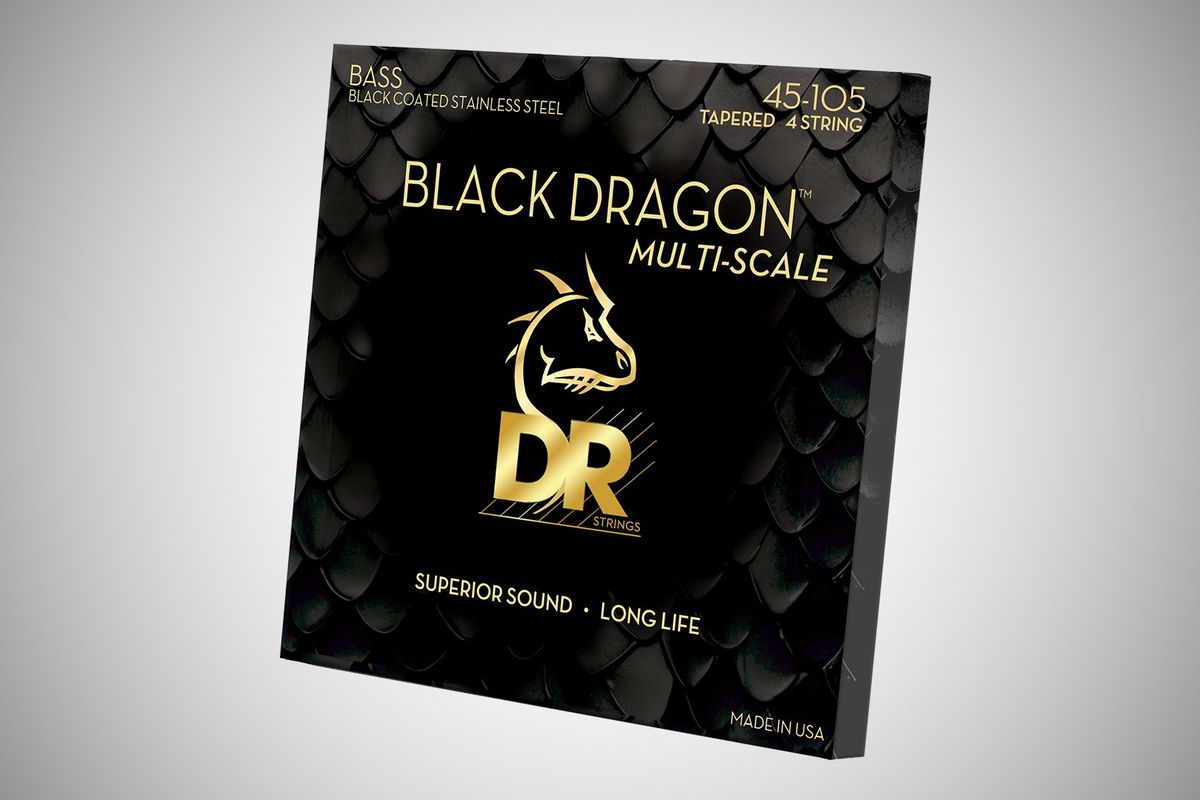
DR Handmade Strings has introduced their highly engineered new Black Dragon Multi-Scale Bass strings. Combining the sound, feel and extra-long life of Dragon Skin+ with an exciting black finish, these new strings will bring out the best tone (and look!) of any multi-scale bass, including those with up to 37” B strings.
The new Black Dragons are available in 4-string, 5-string and 6-string sets and feature DR’s patented Accurate Core Technology (ACT). ACT upgrades the architecture of the strings, allowing them to vibrate to their full potential and deliver full tone and clarity for even the lowest notes of your bass. The stainless steel strings feature DR’s Black K3 coating that protects the strings, without choking off the sound, and gives the strings a distinctive black appearance to compliment any instrument. The net result? A great-looking string that delivers enhanced tone, effortless playability and extra-long life.
Black Dragons carry street prices of $39.99 (4-string set), $49.99 (5-string set) and $52.99 (6-string set). They will be available starting August 17th in honor of DR Strings founder Mark Dronge’s 87th birthday. For more information visit drstrings.com.
Holy Grail 'Bursts: BEST OF Rig Rundown
The likes of Joe Bonamassa, Jason Isbell, and Richie Faulkner walk us through a carousel of vintage Gibson Standards
Trace the journeys of some of the world’s rarest guitars including cherry sunbursts pulled from pawnshops, a scorching ’59 that simply refused to be left behind, and more. Along the way these legends debunk hand-winding myths, detail meticulous restorations, and share the emotional pull of instruments that have crossed continents and shaped Rock and Roll.
Mile End Effects Pique Review
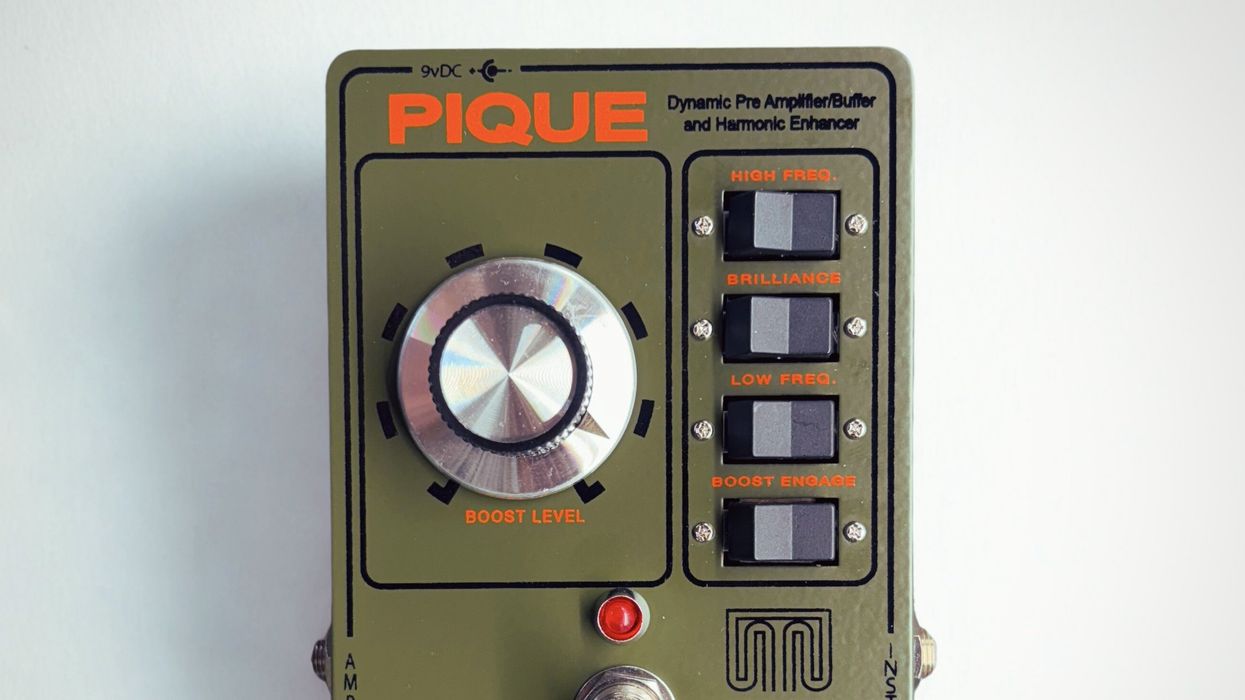
A handsome 3-in-1 boost, EQ, and filtering stomp offers unique tonalities.
Mile End Pique Demo Vid
Mile End Effects’ Justin Cober, who runs the one-man operation out of his Montreal basement, advertises the Pique as a “dynamic preamplifier, buffer, and harmonic enhancer.” That’s a mouthful for what looks like a fairly simple stomp with single knob and four rocker switches, but the Pique lives up to the billing. It’s one of the more creatively stimulating and inspiring boost/EQ/buffer combos I’ve encountered.
Pique Behind the Curtain
The Pique’s design is rooted in the company’s Preamp 150, which is an homage to the preamp in the Roland RE-150 Space Echo. But the Pique has a much wider range of capabilities. Rather than just boosting one frequency or another, the Pique creates, as Cober puts it, “higher-order harmonics by implementing filtering, very slight phase shifts, and musically related harmonics to the audio signal.” Each of the three EQ-related switches functions a little differently.
The brilliance switch employs a capacitor to filter low-end frequencies and emphasize midrange. The “high freq” control runs upper frequencies through an op-amp circuit that generates distortion and extra harmonic content, while lower frequencies remain unaffected. “Low freq,” on the other hand, uses a phase-shifted low-pass filter to achieve similarly targeted saturation and compression on the opposite end of the EQ spectrum.
The boost switch activates the Preamp 150 section, and the unit’s prominent knob controls the effect’s level. This all makes the Pique a cinch and a pleasure to use: four switches, one knob, less overthinking, more playing. Keep in mind that the pedal requires 250 mA to operate—a much higher draw than most boost or EQ pedals. It’s more than the draw from most simple boost or EQ pedals.
Pique Performance
The Pique’s buffer can be activated alone by turning all the rocker switches off and turning the pedal on. It gives a just-noticeable lift to a dry signal, especially in the airy high frequencies that drip away over a lengthy signal chain. Switching on the Preamp 150 boost circuit takes that lift further, lending presence, chime, and breadth to whatever you feed it. It’s a great always-on effect, but the extra clarity and sparkly high end make it a great lead boost if you kick up the level.
The harmonic excitement aspect of the pedal, though, is where the Pique opens up new avenues. Cober’s design considerably thickens selected frequencies, which feels like the sonic equivalent of turning a fine-tip pen into a broad, inky marker. And rather than simply a surgical, colorless EQ bump, the Pique’s frequency boosts often feel like distinct, specialized effects that blend overdrive, clean boost, and EQ. They accentuate certain elements of your guitar’s signal, for sure, but they also stretch them with subtle harmonics and sometimes delicate, almost imperceptible distortion.
These functions are especially rewarding when the Pique is applied after your dirt pedals, where it excites and texturizes certain elements of other pedal tone profiles. If you’re missing bottom-end heft, flip on low freq, and instead of a blunt bass boost, you’ll perceive a more powerful and immediate low-end character. Add in brilliance and your mid frequencies will experience a similar metamorphosis, yielding much grittier prominence. High freq can yield the same pleasing effect, though some players will want to be careful about how it highlights rogue high frequencies from gain devices in front of the Pique.
The Pique isn’t your average boost or EQ pedal. It’s full of unique sounds that are clearly a product of inventive circuit-tinkering, but also hits the mark for many basic EQ, buffer, and boost functions. To top it off, Cober’s circuit design is matched by his aesthetic eye. Pique is definitely one of the best-looking stompboxes on the market.
PRS Guitars Releases New Rules of Tone Video Series
PRS Guitars today released the first episode of a new video series on the PRS “Rules of Tone.” The Rules of Tone is a document written by Paul Reed Smith back in 2006, in which he documented 21 “rules” that he and the guitar makers at PRS follow in order to ensure instruments of the highest quality.
“It was meant to be a guide so that I/we always build the best instruments we can possibly make. There are 21 rules – each one the culmination of decades of experience in guitar-making, design, and repair work. While no set of rules can guarantee a perfect instrument, a guitar should improve with each instance of a rule followed – in the end becoming greater than the sum of its parts,” said Paul Reed Smith.
The video series will be published as six episodes in total. Episode 1 focuses on woods and is available now at this link. Remaining topics include: necks, pickups, finish, hardware, and setup. In each video, Paul Reed Smith is joined by a member of the PRS Guitars manufacturing team to talk about how the guitar-making philosophies are applied in practice on the manufacturing floor. To see each episode as soon as it is released, subscribe to the PRS Guitars YouTube channel and click the bell for notifications.
“Since 2006, I have spent a lot of time teaching these guitar-making principles to the teams here. The teams have, in turn, become stewards of the rules to every person who makes guitars for PRS. Please enjoy these videos. It is my hope that they give you an idea of the amount of care and constant improvement we dedicate ourselves to, so that you receive our best,” said Paul Reed Smith.
PRS Guitars continues its schedule of launching new products each month in 2025. Stay tuned to see new gear and 40th Anniversary limited-edition guitars throughout the year. For all of the latest news, click www.prsguitars.com/40 and follow @prsguitars on Instagram, Tik Tok, Facebook, X, and YouTube.
The Glen Campbell Effect

Glen Campbell’s sound is inspiring on many levels—in addition to his distinctive voice, his nuanced and virtuosic guitar playing allowed him to interpret some of the most iconic songs of his era. Among them, the songs of Jimmy Webb stand out immediately. Classic pieces such as “By the Time I Get to Phoenix” and “Wichita Lineman” are instantly recognizable for their vivid storytelling and unforgettable melodies. It’s interesting to note that Webb composed on piano, utilizing the instrument’s vast harmonic capabilities to craft structures less conventional than the typical radio single.
In the hands of Campbell, his guitar playing truly shines as much in his comping as in his famous soloing during live performances. I composed my piece, “Jed’s Theme,” based on a character in a novel written by my sister, Christina Rauh Fishburne, with Webb and Campbell’s influence very much at the center. It can be heard on my album with Cameron Mizell, Local Folklore (Destiny Records).
Note: I play this piece with hybrid picking (pick/middle/ring), but it can also be played fingerstyle if that’s more comfortable.
Ex. 1 (Measures 1–8)
The beginning of the tune establishes a simple melody line over a harmonic bed that utilizes inversions and substitutions for color. An element of Campbell’s accompaniment style that I love is his ability to sculpt emotion to support the melody. In an instrumental context like this, using a Gm as a passing thought in measure 2 is a way to emote harmonically while only briefly straying from the key of D major. The decision to use F# in the bass of the tonic D chord also provides a chromatic line as we move through D/F#, Gsus4, Gm, D/F#, and G6. These nuanced voicing movements help to create an atmosphere for the melody beyond the typical options. The rocking back and forth of the bass notes also provides a momentum to move up to the V–IIIm–IV cadence that ends with a first position line over Gmaj. Adding such lines in an instrumental tune can be a fun way to insert “guitar” back into the melody. By this I mean that until then, think of the melody as a voice. The melody sings its entrance and comes to a pause, leaving space for the guitar to respond before moving on.
Ex. 2 (Measures 9–16)
Here, we find ourselves back in the “voice” melody but now E/G# is introduced as a harmonic shift to bring light into the melodic narrative before closing out the phrase by resolving to a Dmaj walk up. At the start of the song, the melody hangs on the G6 chord before extending tension over the V and IIIm chords and settling on the IV chord before beginning its next statement. This time, we bring the melody to a secondary dominant with the V of V (E/G#) before finally resolving to the I chord. This is a mechanism often found in the Webb/Campbell songs that allows a melody to remain consistent while simultaneously offering emotional development.
Ex. 3 (Measures 17–23)
We begin here with a higher melodic line voiced over the V chord before descending out of the key briefly to Fmaj7–Fmaj9–Cadd9. Following this, another “guitar” line enters to lead us back into D major by closing out the phrase on A7, further utilizing harmonic movements under the melody to introduce new emotive colors and support the melody.
Ex. 4 (Measures 9–13, coda ending)
To bring the song to an end, we take the D.S. al Coda and introduce a final harmonic shift with the G/Ab beginning the coda and ending on the unresolved Gm. These choices are both ways in which a song can be brought to a closing that feels open-ended, which is different than incomplete. Rooted in the key of D major, the song remains mostly grounded in the tonality with various harmonic divergences to accent the melody. By ending the song on the Gm, or the IVm, we may insinuate that a story is still being told after the song is finished. This is a mechanism often used to accentuate unresolved tension in vocalized lyrics and can have the same effect with instrumental music when thoughtfully placed.
Ex. 5
For Ex. 5, we’ll play the complete piece, keeping in mind that it’s important to hear the melody lyrically, and the harmony as emotional color in support of it.
Shure Nexadyne Mics on Tour with Deep Sea Diver
PG's Chris Kies catches up with Jessica after filming DSD's latest Rig Rundown to get her first impressions of the Nexadyne lineup.
Deep Sea Diver's Jessica Dobson is a longtime fan of Shure mics on stage and in the studio. So, when Shure outfitted their latest tour with the new Nexadyne series mics, the band was excited to put them through their paces to see how they stack up against legends like the sm57 and sm58 for reliability and tone.
Shure Nexadyne 5 Guitar Amp Microphone
Nexadyne 5 Amp Mic, Blk
The Nexadyne™ 5 Dynamic Guitar Amp Microphone is a supercardioid dynamic microphone for professional live performance, featuring patented Shure Revonic™ dual-engine transducer technology.
Shure Nexadyne 8/S Dynamic Vocal Microphone
Nexadyne 8/S Supercard Vocal Mic, Blk
Dynamic Vocal Microphone with Cardioid Pickup Pattern, Dual-engine Design, Revonic Transducer Technology, Dent-resistant Grille, Mic Clip Stand Adapter, and Zipper Case
Shure GLXD16+ Digital Wireless Guitar Pedal System
GLXD16+ Wls Gtr Pedal Sys
Verso Sine Review
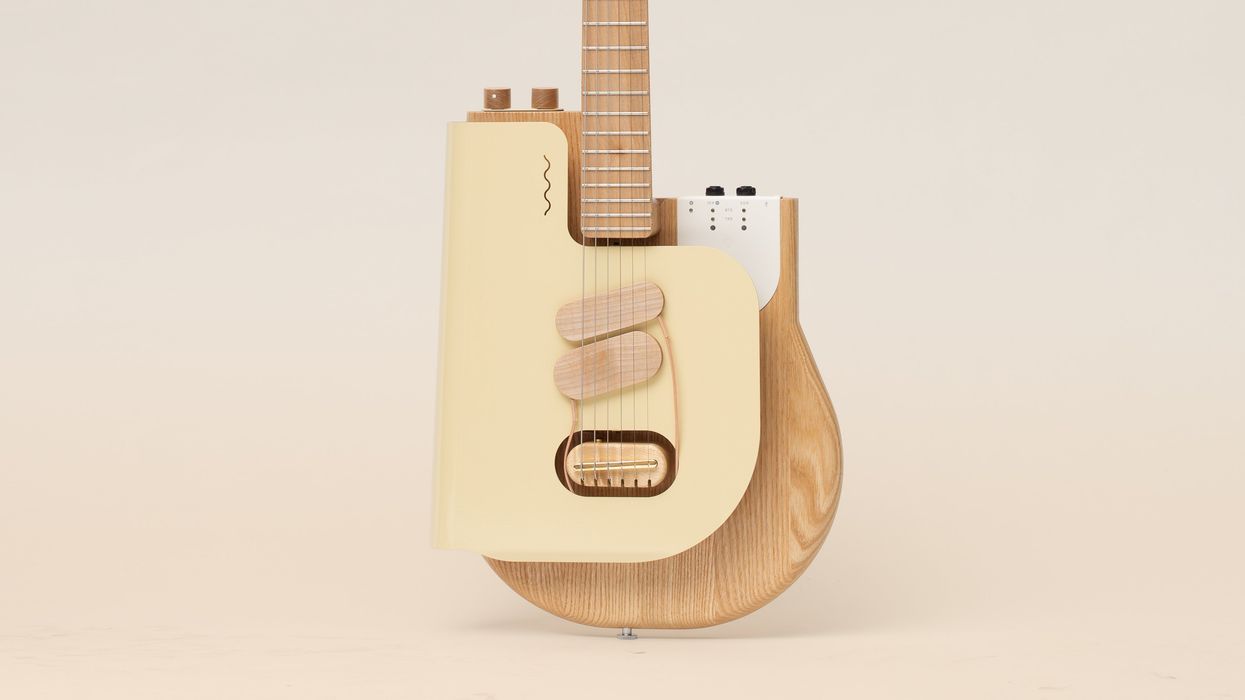
Verso demo
Over the course of electric guitar history, there have been many experimental builds. Some have been successful and changed the path of guitar design, while others have come and gone, surfing the seas of change. The Verso Sine, though, lives in a third, less common category—an artistic realm populated by names like Wandre and Manzer, where visionary builders rule the roost.
Since launching Verso a handful of years ago, Germany-based builder Robin Stummvoll has caught the attention of intrepid design fans with his minimal, sheet-metal-bodied Cosmo guitar, Orbit baritone, and Gravis bass. His distinctive style is based on future-leaning aesthetics that also draw on the early history of electric guitar design—specifically Rickenbacker’s sheet-metal lap steels—as well as mid-century furniture and architecture.
With the Sine, Verso pushes further ahead. Aesthetically, this model would sit nicely in the design wing of a modern art museum, maybe across the hall from an Eero Saarinen exhibit. That alone is cause for excitement. But the Sine, described by Stummvoll as an “expressive guitar,” offers a playing experience unlike any other guitar I’ve laid my hands on. And that is the real experiment at the heart of this fantastic instrument.
Rethinking Guitar Design
Unlike its metallic siblings, the Sine is actually made of a solid ash body with a set neck—available as ash, maple, cherry, oak, or walnut—with the option of a 16" or compound 9 1/2"–16" radius. The Sine Pad, a 1 mm-thick piece of bent sheet metal that’s affixed to its body, serves as the guitar’s top and home to the pickups.
The Sine Pad opens up a world of possibilities that are game-changing, highly innovative, and practical. First, there’s the pickups. Since the Sine Pad is powder-coated steel, the magnetic pickups cling to the top without needing to be permanently affixed, so they can be moved in any direction. That means they can be shifted in relation to the strings to shift the tone. But thanks to stereo-output options (which are configured on the back of the guitar, where the guitar’s input jack is located, and where the pickups plug in via mini audio jacks), both of the Sine’s single-coil pickups can be moved so one pickup captures only the top strings and the other captures just the bottom. The resulting stereo imaging effects can be pretty wild.
Because the Sine Pad is a floating, spring-loaded piece of sheet metal and the brass bridge is independently situated on the body, you can also create volume-swell effects by pressing on the top without changing pitch. I found that a different kind of musical intuition comes into play when working with the Sine Pad. The control it offers is more nuanced and directly tied to my picking hand technique than what I would achieve with a volume pedal or knob. It’s a great tool for quick, expressive swells.
Volume isn’t the only control the Sine Pad has to offer. An onboard LEHLE EXPRESSION module is connected to the Sine Pad, with two expression outs (it’s also compatible with CV and USB MIDI) that I used to control pedals with expression options. Plugged into my Red Panda Tensor or Moog Minifooger MF Delay, I experienced a sense of effect control like never before. I tapped into delay times both subtle and extreme with the same intuitive gestures that controlled my chord and note attack. It’s something I haven’t been able to emulate without the Sine—a unique feeling almost like playing with a whammy bar for the first time.
The Essential Guitar-ness of the Sine
The Sine’s wild innovations wouldn’t mean much if it weren’t an excellent guitar. Sure, it looks completely unlike anything else. But holding the Sine in my lap, closing my eyes, and putting fingers to frets and strings, it’s a comfortable, playable instrument. It’s a little body-heavy, and the lack of curvature on the lap side means it can drift if you don’t sit with it centered. But those issues aside, the drawbacks are few.
The fretboard feels great, and there’s plenty of access to each of the Sine’s 22 nicely rounded Jescar frets. Acoustically, it’s loud and resonant, with warm but metallic overtones similar to my Jazzmaster with an aluminum pickguard, or a fuller, bigger guitar version of my sheet-metal Rickenbacker NS lap steel. The pickups certainly play a role in balancing the metallic overtones, and their wooden housing even gives a little extra sense of warmth, at least visually. Yet as fun as it is to lean in and dose the Sine with enough effects to match its futuristic tendencies, this well-rounded sonic foundation demanded I spend just as much time using its clean tone to play complex voicings across the neck.
The Verdict
The Sine is essentially an experimental instrument for daring players looking for something different. It absolutely succeeds, however, not only by offering a range of expression unlike any other guitar, but by doing so in a way that is simple and practical—a combination that defined the greatest mid-century guitar-design icons. I’ll share one warning for those who experiment with this guitar, though: Since parting with the Sine, I’ve missed the sense of expression it put at my fingertips, and there’s only one way to experience that feeling again.
What's New: August 16, 2025
Whiskey Myers Rig Rundown with John Jeffers & Cody Tate

The high-powered Southern rockers return for a full-on Rig Rundown.
This “Les Paul” Isn’t What You Think…
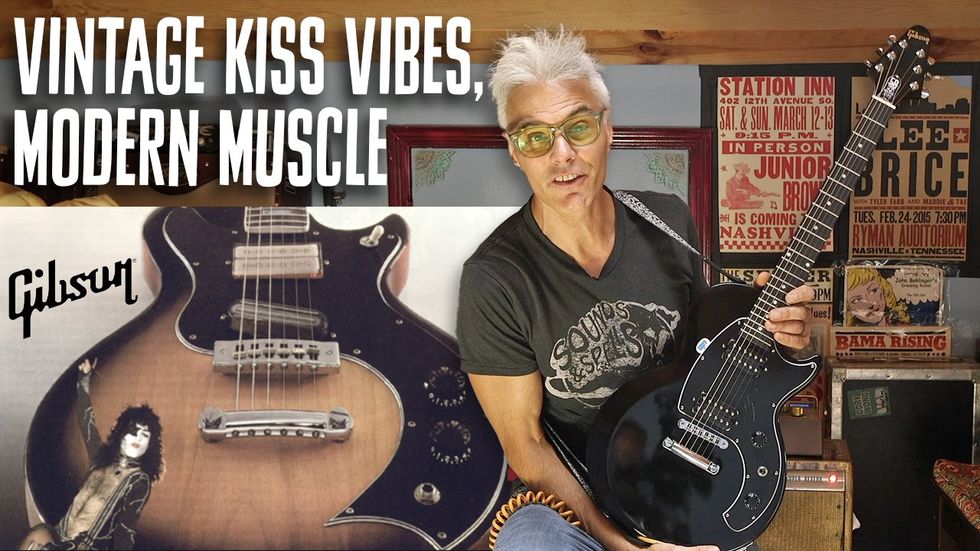
Gibson commemorates 50 years in Nashville with an unexpected, limited edition evolution of their understated Marauder.
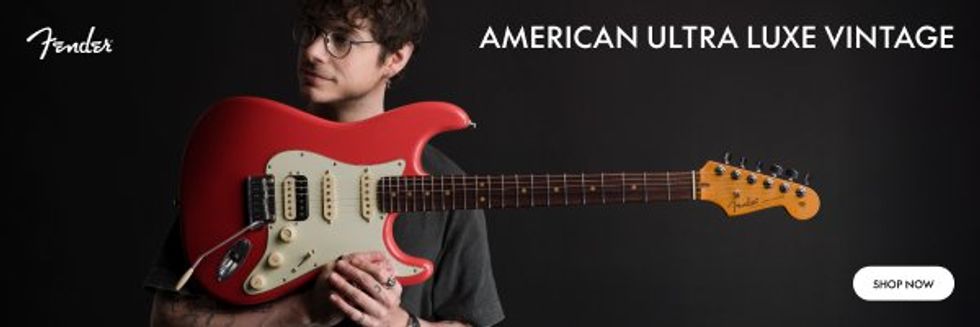
Verso Sine Review
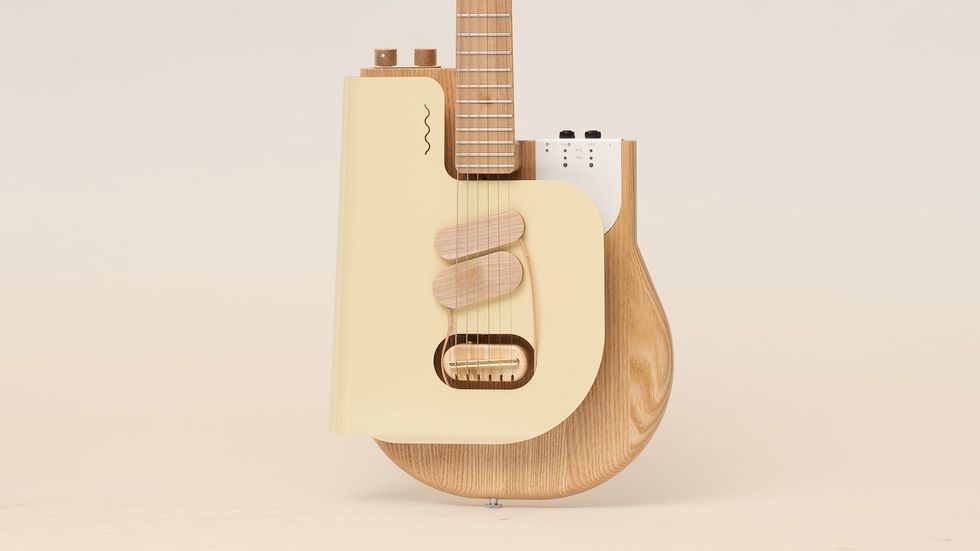
Unique expressive features from a futuristic instrument that still nods at electric guitar design history.
Gibson Custom Creates Noel Gallagher Les Paul Standard

Exclusive: Full details of the black Gibson Les Paul Standard seen and heard at Oasis reunion shows

PRS Guitars Releases Special Limited Edition of the CE 24

PRS Guitars today announced a new limited edition: the PRS CE 24 Special. “Special” in the name refers to this guitar’s hum/single/hum pickup configuration, a first for the CE bolt-on platform. Only 1,500 of this limited-edition model will be made for 2025.
Megadeth to Release Final Album in 2026

Global music icon Dave Mustainereveals next album will be final studio albumof his more than four-decade career.

Emerald Guitars Unveils Black Opus Acoustics
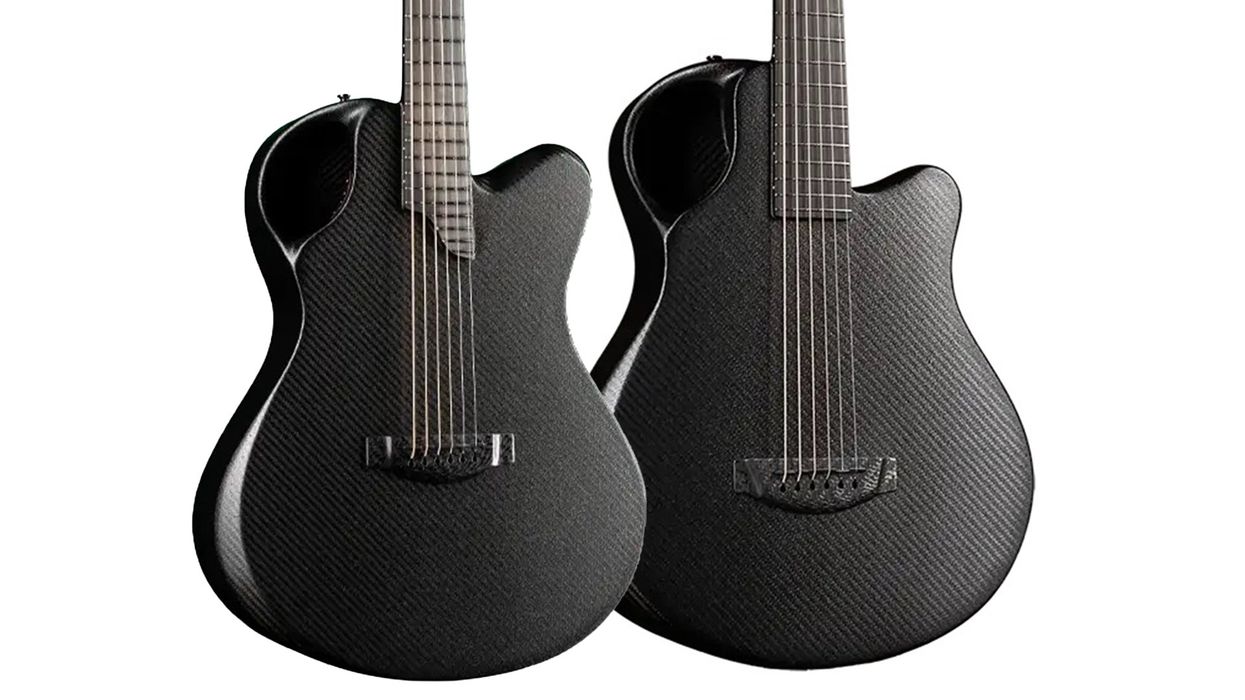
Emerald Guitars has introduced its most accessible range yet, the Black Opus Series of acoustics. Crafted for players who want that Emerald tone, playability, and reliability without paying for custom aesthetics or extras, the Black Opus comes in two sizes: the X7 parlor guitar and the signature dreadnought X20.
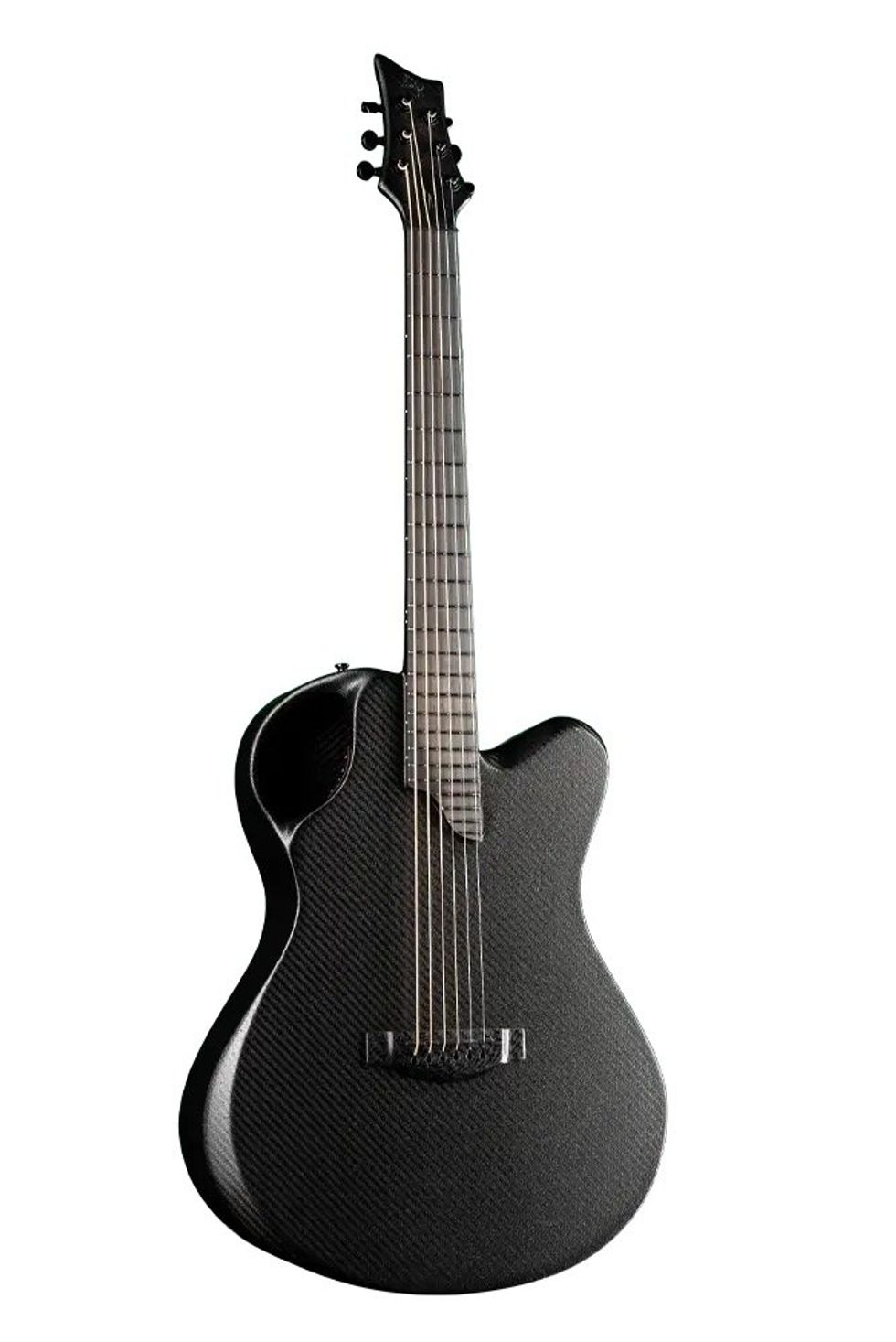
Focused on sound, playability and reliability, the stripped-back Black Opus is the definitive no-frills Emerald — including a Crystal Ice satin finish and streamlined component choices. Emerald Guitars has reduced the cost without reducing quality. The Opus series come with no veneers or custom options – just the essentials. Paired with a minimalist, studio-grade preamp design, it delivers a warm, clean signal that preserves the true voice of the guitar. That sums up the Black Opus philosophy: pure tone, no excess.
Built in Donegal, Ireland to the same standards as every Emerald, the Black Opus features include:
- Black carbon fiber weave with Crystal Ice satin texture finish
- LR Baggs Element Bronze undersaddle piezo pickup
- Emerald 14:1 gear ratio tuners
- Pinless carbon bridge, full carbon fiber construction
- Ergonomic, comfortable designs
- Expert setup and PLEK service
- Emerald Gig Bag included
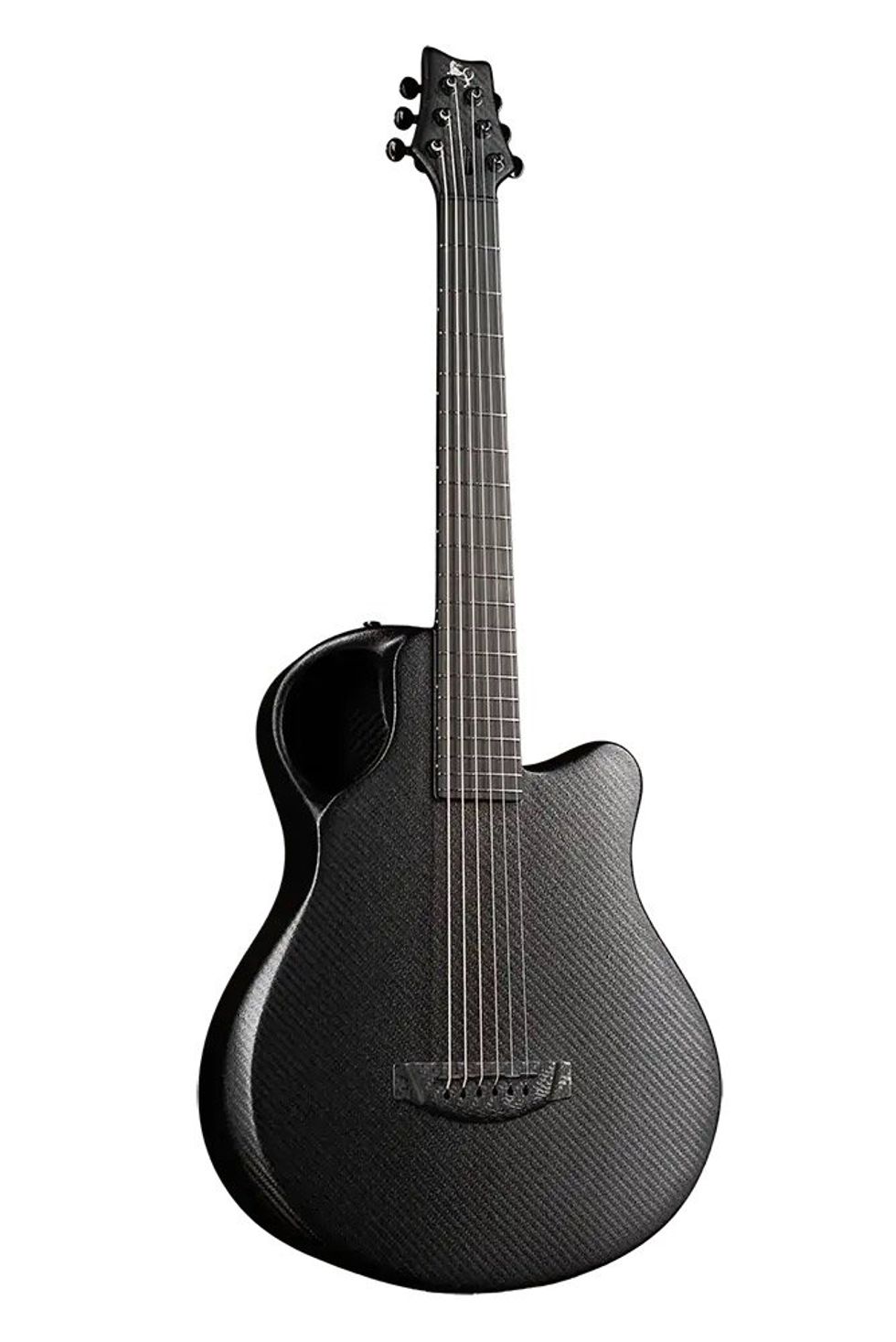
The Black Opus X7 is Emerald’s compact, parlor-sized acoustic — designed for players who want full-bodied tone in a smaller, travel-friendly form. With its ergonomic carbon fiber body and 24” scale length, the X7 offers comfort and playability, whether you’re at home, on the road, or on stage. Despite its small footprint, the X7 delivers a surprisingly rich and balanced tone, for those seeking portability without compromise.
The X20 Black Opus is designed for players seeking a rich, full-bodied acoustic tone with comfort and durability. Its ergonomic carbon fiber body contours naturally to the player, allowing for long sessions of effortless performance — on stage, in the studio, or on the road. Since its debut, the X20 has remained Emerald’s most popular model — a bold evolution of the traditional dreadnought. With extended neck access, a subtle rib bevel, and a contoured fretboard end, the X20 delivers advanced playability and a modern feel while staying true to its original character.
The X20 Black Opus dreadnought carries a street price of $1895; the X7 Black Opus parlor model carries a street price of $1695. For more information visit emeraldguitars.com.
This “Les Paul” Isn’t What You Think…
Gibson commemorates 50 years in Nashville with an unexpected, limited edition evolution of their understated Marauder.
For 50 years, Gibson has been proud to call Nashville home, shaping sound, supporting the artists who make our community special, and crafting the guitars that have defined generations of music. Now, we’re honoring that legacy with something new. Introducing the Les Paul Music City Special – 50th Anniversary, a tribute to where we’ve been and a celebration of where the music will lead next.
The Music City Special – 50th Anniversary is an updated, modern twist on two historical Gibson models, taking much of its inspiration from the 70s-era Marauder, with a touch of the Music City Junior in its DNA. Over the years, the Marauder has been used by artists from Adam Jones to Paul Stanley. This unique commemorative model pays tribute to the early days of Gibson’s Nashville production and celebrates Gibson’s 50 years of producing world-class guitars in Music City while delivering outstanding value to modern players.
Megadeth to Release Final Album in 2026

Global music icon Dave Mustainereveals next album will be final studio albumof his more than four-decade career.

Megadeth’s Dave Mustaine revealed in a social post directly shared with his worldwide fanbase and Cyber Army that his forthcoming album (due out early next year) will be the final MEGADETH studio album of his career. Mustaine shared the announcement via his alter ego Vic Rattlehead. Mustaine also revealed that the multi-platinum superstar band will embark on a global farewell tour kicking off in 2026. Also set for next year is a new memoir from Mustaine, details of which will be revealed in the coming months.
“There's so many musicians that have come to the end of their career, whether accidental or intentional,” Dave Mustaine says. “Most of them don't get to go out on their own terms on top, and that's where I'm at in my life right now. I have traveled the world and have made millions upon millions of fans and the hardest part of all of this is saying goodbye to them.
Dave adds, “We can't wait for you to hear this album and see us on tour. If there was ever a perfect time for us to put out a new album, it's now. If there was ever a perfect time to tour the world, it's now. This is also a perfect time for us to tell you that it's our last studio album. We've made a lot of friends over the years and I hope to see all of you on our global farewell tour. Don't be mad, don't be sad, be happy for us all, come celebrate with me these next few years. We have done something together that's truly wonderful and will probably never happen again. We started a musical style, we started a revolution, we changed the guitar world and how it's played, and we changed the world. The bands I played in have influenced the world. I love you all for it. Thank you for everything.”
Megadeth are set to release their forthcoming album via Mustaine’s Tradecraft imprint in partnership with Frontiers Label Group’s new BLKIIBLK label. It will launch with the project's first single (TBA) in tandem with global pre-orders this fall.
Fans can click HERE to register for early access to exclusive information and offers surrounding the forthcoming final album and all Megadeth news. In addition, look for the initial run of farewell tour dates to be announced later this year.
PRS Guitars Releases Special Limited Edition of the CE 24
PRS Guitars today announced a new limited edition: the PRS CE 24 Special. “Special” in the name refers to this guitar’s hum/single/hum pickup configuration, a first for the CE bolt-on platform. Only 1,500 of this limited-edition model will be made for 2025.
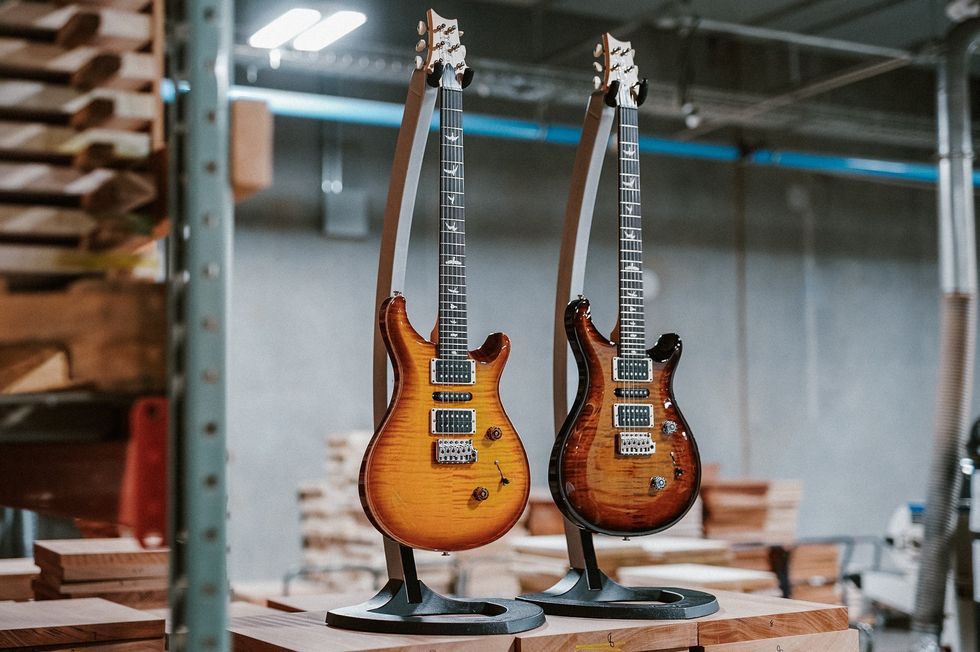
While the CE 24 normally features two PRS 85/15 pickups in the treble and bass positions, the CE 24 Special adds a PRS NS-01 single coil in the middle position. The three-pickup layout brings more tonal options to players, and the 5-way pickup selector switch helps players shape their preferred sound.
“With the CE 24 Special, you get all the iconic tones you expect from a CE. But now, with the middle pickup from the Modern Eagle V added to the mix, you can easily dial in the classic scooped tones typically associated with traditional 3-pickup/5-way switch-equipped guitars. Thanks to the tonal range of the 85/15 humbuckers, the CE 24 Special offers even more warmth and versatility than some historic models with a similar setup,” said Chuck Lenderking, PRS Guitars Product Manager.
True to the CE family of guitars, this model features a bolt-on maple neck, providing a snappy attack and enhanced resonance. The Pattern Thin neck profile and satin finish on the neck offer fast playability and comfort.
PRS Guitars continues its schedule of launching new products each month in 2025. Stay tuned to see new gear and 40th Anniversary limited-edition guitars throughout the year. For all of the latest news, click www.prsguitars.com/40 and follow @prsguitars on Instagram, Tik Tok, Facebook, X, and YouTube.
Whiskey Myers Rig Rundown with John Jeffers & Cody Tate
The high-powered Southern rockers return for a full-on Rig Rundown.
From couchsurfing to playing the Ryman, rockers Whiskey Myers of Palestine, Texas, have had one hell of a Cinderella story. We caught up with guitarist John Jeffers back in 2021 for a virtual Rig Rundown, but this time around, ahead of the September release of their seventh LP, Whomp Whack Thunder, PG’s Chris Kies met up with Jeffers and rhythm guitarist Cody Tate before their July 19 gig at Nashville’s Ascend Amphitheater to get a tour of their latest and loudest noisemakers.
Brought to you by D’Addario.
Parting Gift
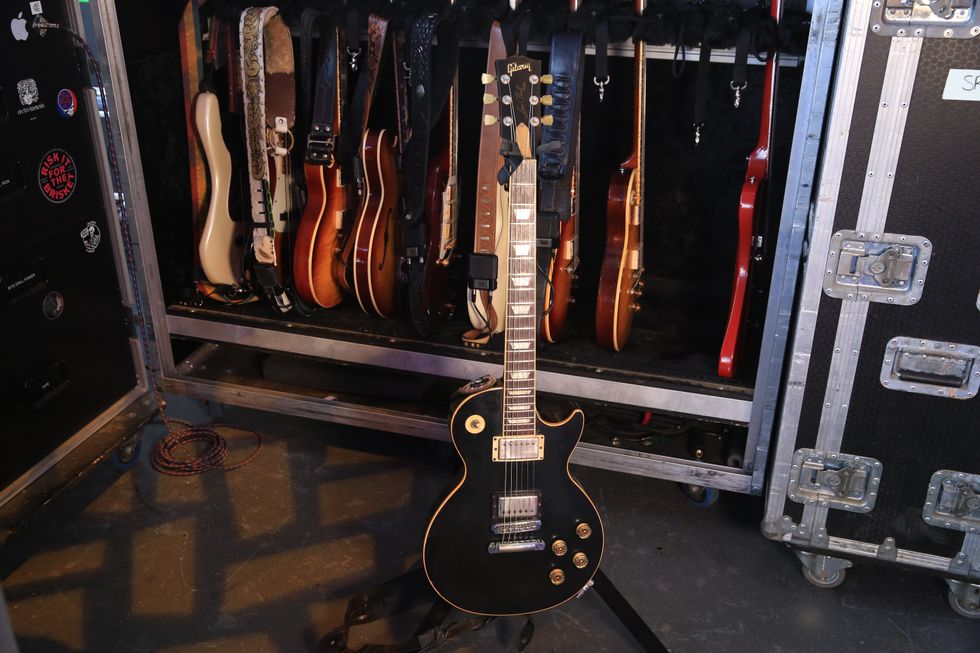
This ’90s Gibson Les Paul is Jeffers’ most treasured guitar, gifted to him by Tate’s uncle—an avid collector—before he passed away. It’s loaded with a DiMarzio Super Distortion and a “Jeff Beck” pickup, which is how it came to Jeffers. He strings it with .0105s.
Murphy Magic
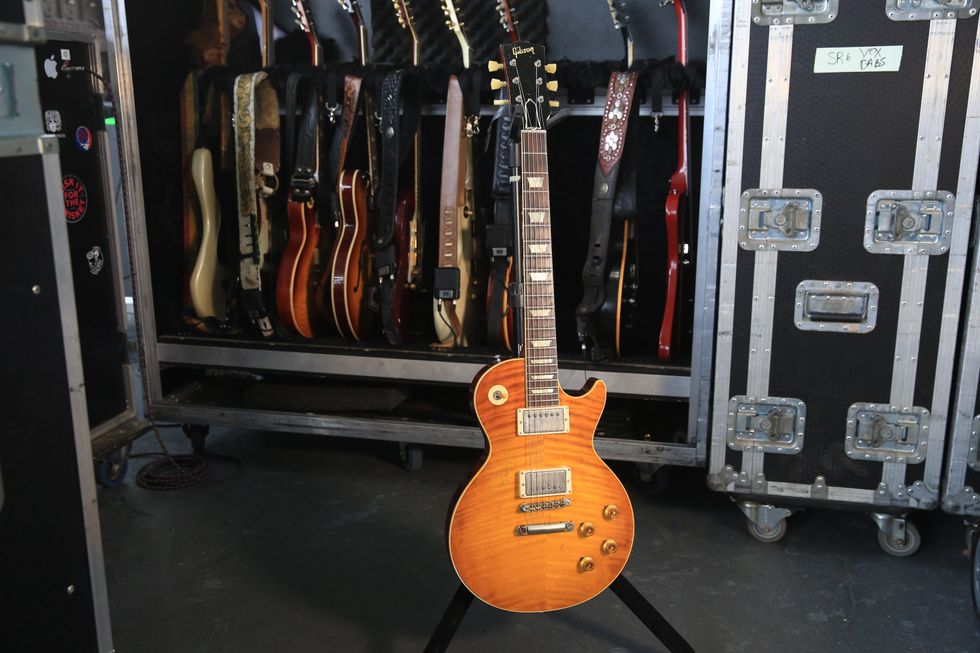
This 1960 Les Paul reissue was hand-painted by Gibson’s custom-shop whiz, Tom Murphy.
Flavor of the Night
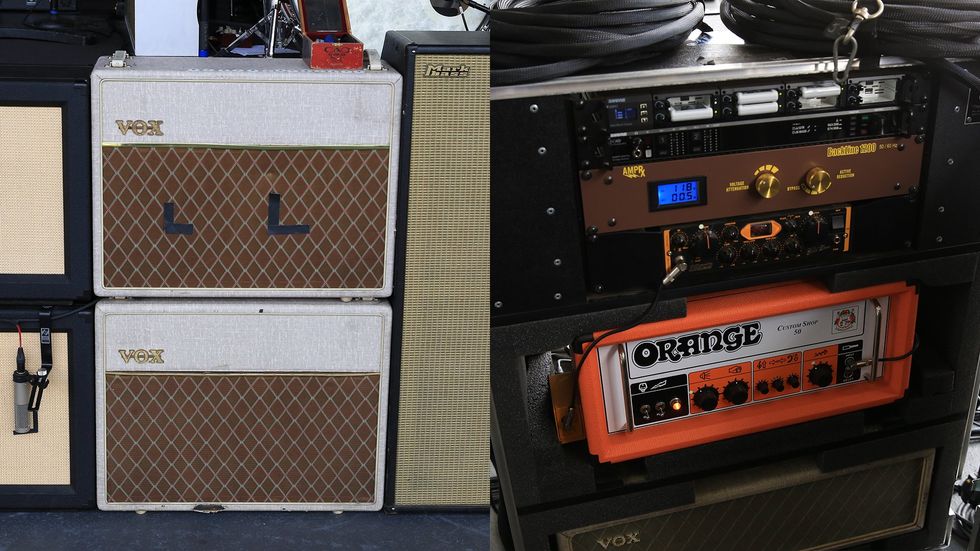
Jeffers has long been a Vox AC30 Hand-Wired player, but recently he’s been throwing Oranges into the mix, including a Custom Shop 50. He’ll decide night-to-night which amp he wants to go with. The Voxes have Weber Silver Bell and Blue Dog speakers, and the Orange has Celestion Vintage 30s.
John Jeffers’ Pedalboard
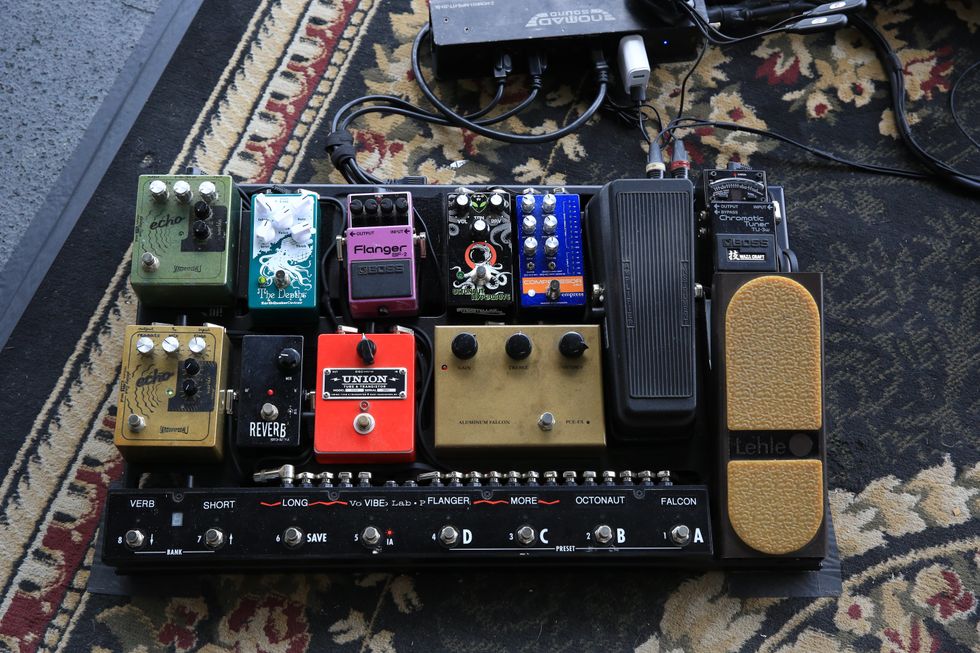
After a Lehle volume pedal, Jeffers stomp station has a Boss TU-3w, a Dunlop wah, PCE-FX Aluminum Falcon, Union Tube and Transistor More, Empress Compress Mk II, Interstellar Octonaut Hyperdrive, Boss BF-2, EarthQuaker Devices The Depths, two Skreddy Echos, and a Hermida Audio reverb. Jeffers jumps around them all with a Voodoo Lab PX-8 PLUS True Bypass Programmable Pedal Switcher.
Guitar Center Special
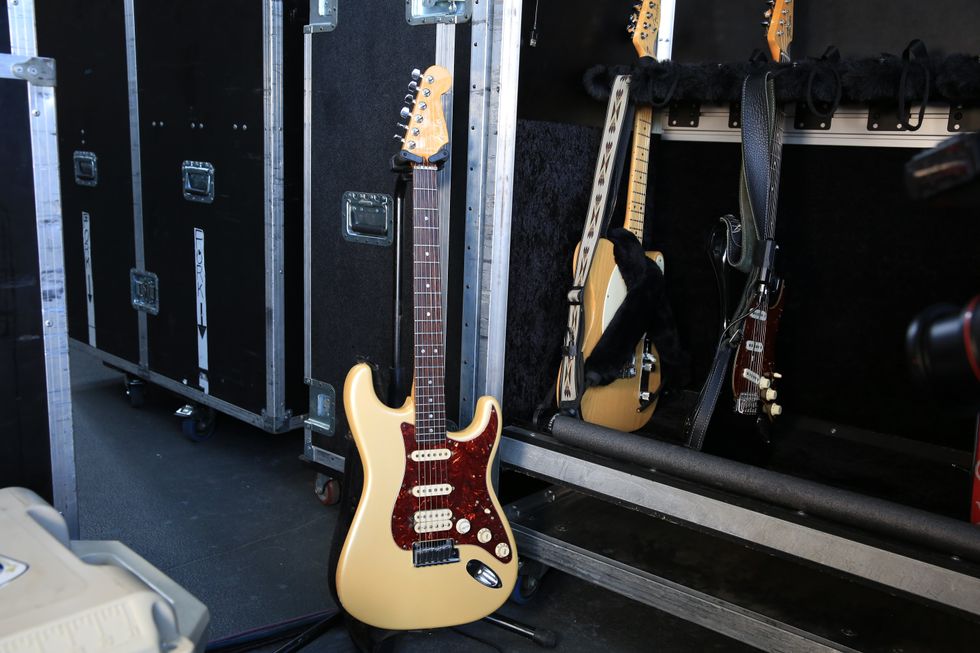
Tate calls this Fender Stratocaster a “Guitar Center special,” which he’s had for 15 years now. It’s mostly stock, save for some custom wiring. He plays it with Ernie Ball Slinkies, mostly in the middle position for rhythm playing.
Brown Beauty
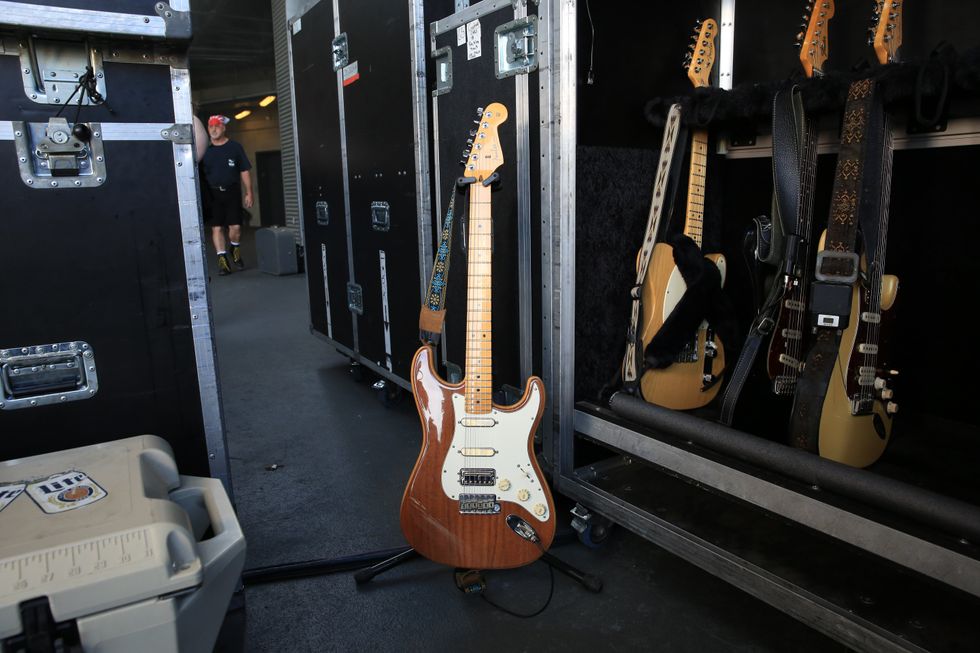
Tate fell in love with this heavily modded Strat when he saw it on Reverb, and he had to pull the trigger. He’s not sure what the pickups are—especially the Gretsch Filter’Tron-style bridge unit—but it’s got the signature Strat bounce with a bit of extra grease.
Marshall Law
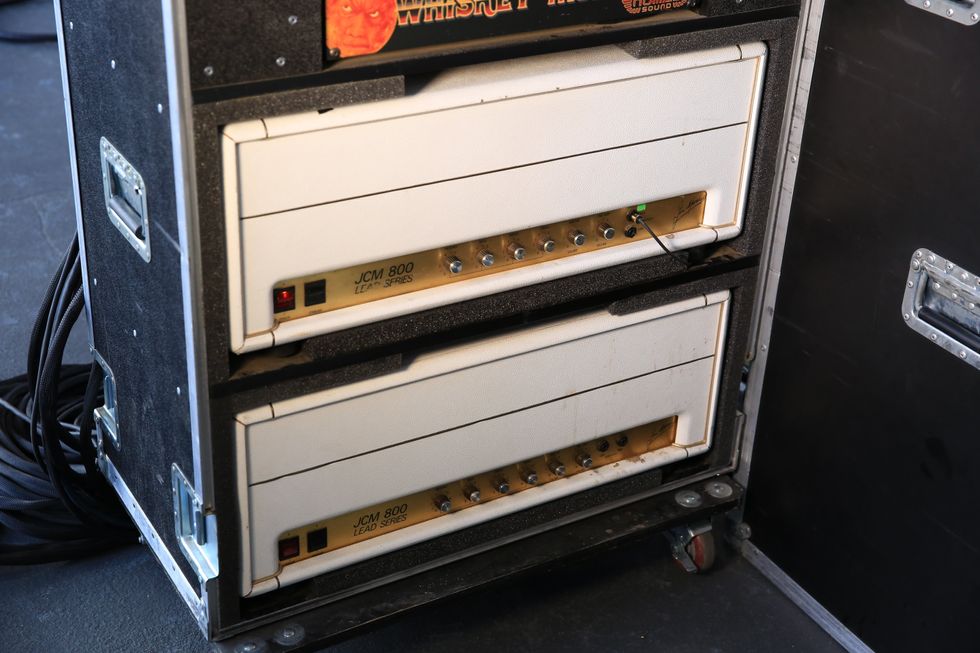
Tate runs two Marshall JCM800s, one 50-watt and one 100-watt, through four custom cabs loaded with Weber 12" speakers.
Cody Tate’s Pedalboard
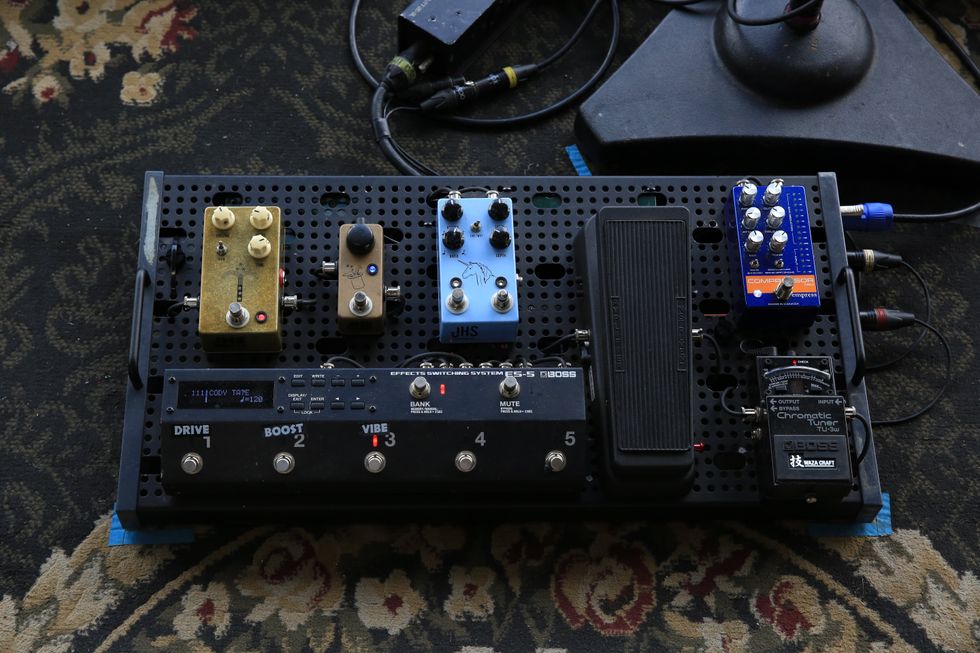
Cody’s board is slightly more restrained than Jeffers’. It includes some of the same units, including a Boss TU-3w, Dunlop wah, and Empress Compressor Mk II, plus a JHS Unicorn, Prestige, and Morning Glory. A Boss ES-5 handles the switching.

EarthQuaker Devices The Depths
What's New: August 12, 2025
"The Best Telecaster I've Ever Played" —John Bohlinger
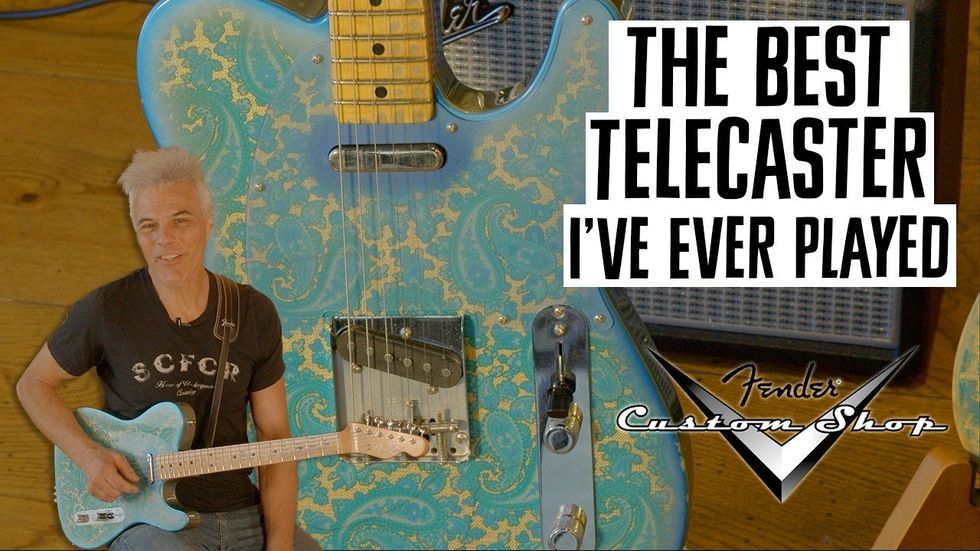
Pablo Picasso had his famous Blue Guitar. Now, so does Brad Paisley, courtesy of the Fender Custom Shop. Last Wednesday, Paisley unveiled his latest signature model, the “Lost Paisley” Telecaster, at a Q&A session and mini concert at Fender’s East Nashville headquarters. The instrument is an exacting reproduction of Paisley’s own, rare 1967 Tele in a stunning, practically glowing, blue-flower paisley finish, with custom-wound Seymour Duncan pickups and a bender that can be set to the B string or, as Paisley prefers, the G string. Spoiler: It looks and sounds badass, even with Paisley playing through a Fender Champ, which you’ll experience when you watch our video. The street price for this limited edition instrument is $7,000.
A Soulful Sound for More Players: Taylor’s Gold Label Collection Grows
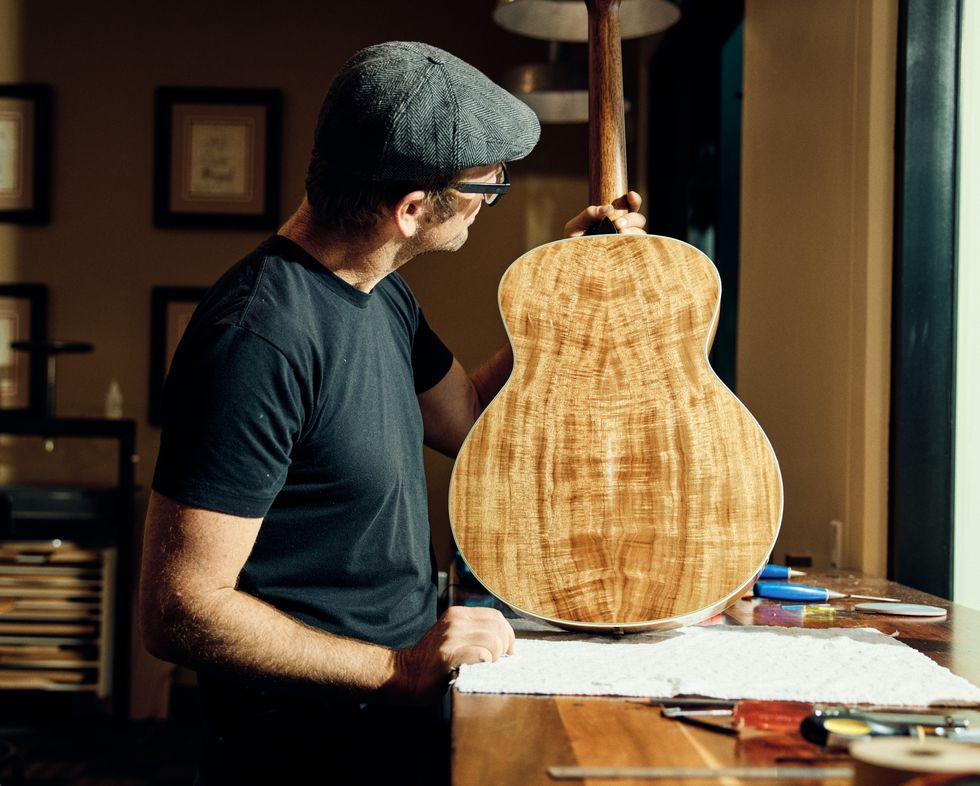
For years, Taylor Guitars design guru Andy Powers was ruminating on a sound. It was something deep and warm, with the soul of a bygone era—but unrealized in Taylor’s lineup.
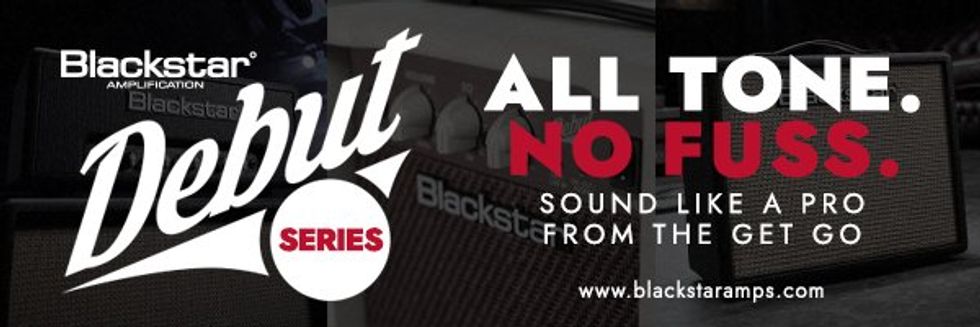
The BIGGEST Metal Pedalboards We've Covered | Rig Rundown BEST-OF

Step into the world of colossal, meticulously crafted pedalboards that power some of the heaviest, most creative guitar tones in modern music.
A Mysteriously Excellent Kay Effector
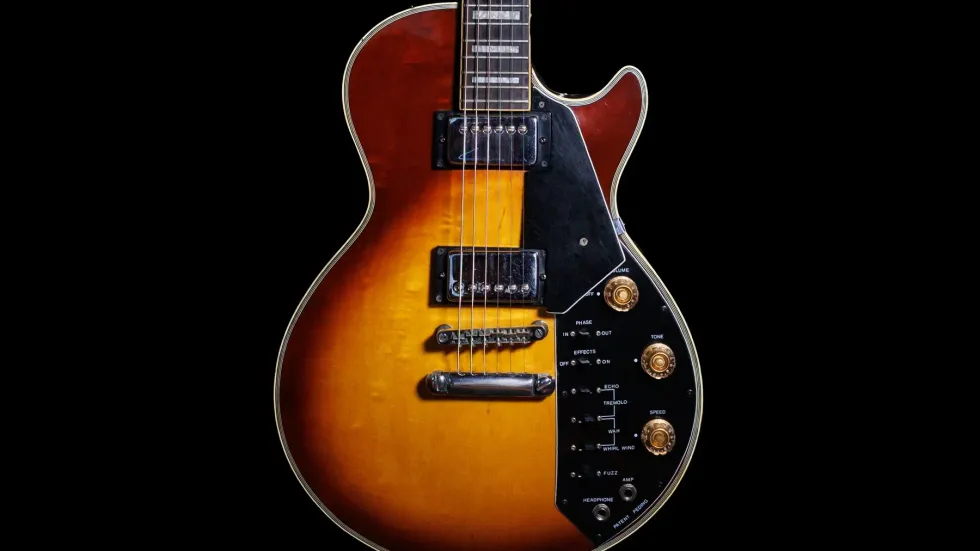
Guitar players today don’t know how good they have it. Inexpensive guitars imported from outside the U.S. are widely available, dependable, and high quality for the price. Folks in the ’60s and ’70s weren’t so lucky. Most instruments made at beginner-friendly price points by brands like Harmony and Kay were inferior to the Martins and Gibsons they copied, but a top-of-the-line Harmony had high-end features. Once you started looking at models with fancy inlays and multiple pickups, some cost even more than low-end and mid-priced Gibsons.
Where to Start with Funk Guitar

The 1960s saw the rise of many legendary guitarists bringing us revolutionary new styles and techniques that we still use and build upon to this day. Arguably, one of the less heralded is Jimmy Nolen whose recordings with James Brown gave birth to the funky 16th-note, scratchy staccato-style playing that has become such an iconic building block of popular music to this day. To cover all the great players who have added their own unique flavor, from Freddie Stone to Nile Rodgers up to Cory Wong, would fill a whole book. But to think of funk guitar playing as purely a gimmick would be a huge mistake as these techniques can be seen across so many styles of music. Ultimately, if you want to be hired as a guitar player, chances are you will need to funk it up at some point. Here are the building blocks to start grooving with the best of them.

Latest News
D’Addario Jack Plugs: Protect Your Gear
Spurr Audio Announces the PMF-8824: A Personal Multi-FX Modulator
Sheptone Pickups Revives Coveted AB Custom Humbuckers


"The Best Telecaster I've Ever Played" —John Bohlinger
Pablo Picasso had his famous Blue Guitar. Now, so does Brad Paisley, courtesy of the Fender Custom Shop. Last Wednesday, Paisley unveiled his latest signature model, the “Lost Paisley” Telecaster, at a Q&A session and mini concert at Fender’s East Nashville headquarters. The instrument is an exacting reproduction of Paisley’s own, rare 1967 Tele in a stunning, practically glowing, blue-flower paisley finish, with custom-wound Seymour Duncan pickups and a bender that can be set to the B string or, as Paisley prefers, the G string. Spoiler: It looks and sounds badass, even with Paisley playing through a Fender Champ, which you’ll experience when you watch our video. The street price for this limited edition instrument is $7,000.
In 1968, Fender introduced the short-lived Paisley Red and Blue Flower finish options on the Telecaster and Telecaster Bass—drawing influences from the “Summer of Love.” These instruments were adorned with decorative Cling-Foil and finished with a matching metallic burst, highlighting the vibrant colors in the intricately patterned paper. Many of these guitars fell victim to the unstable mix of thick paper, weak adhesives, polyester clear coats and time, eventually showing major chipping and flaking, driving players to refinish their guitars. Others we simply repainted to cover up the polarizing original finish. Once discontinued in late 1969, these guitars and basses seemed to vanish into the ether.
Over the following six decades, these unsung heroes of free spirit movement would pop up in vintage guitar shops and for sale online, eventually beginning to accrue a cult-like following. Call it nominative determinism or sheer luck, country music singer-songwriter and Telecaster evangelist Brad Paisley became enamored by these misfit late-‘60s guitars, ultimately becoming the modern-day face of any and all paisley-themed finishes.
Flash forward to present day, and through a fortuitus twist of fate, while Brad was studying guitar building, he was gifted what looked to be lightly used sheets of Blue Paisley patterned Cling-Foil – straight from the ‘60s. Driven by his newfound obsession over this Blue Paisley Cling-Foil, Brad teamed up with close friends Zac Childs and Joe Glaser to not only refinish one of his road-tested 1967 Telecasters, but to meticulously recreate vintage-accurate Paisley Cling-Foil paper.
In partnership with Brad Paisley, the Fender Custom Shop is proud to introduce the Limited Edition 1967 “Lost Paisley” Telecaster. The swirling, pulsing and blinding carousel of blues, greens and silvers of the Blue Paisley Relic finish brings a perfect balance of vintage charm to the unique alder, paulownia and spruce Telecaster body. Featuring a custom ‘60s Oval “C” shaped maple neck and round-laminated maple fingerboard, Seymour Duncan "Lost Paisley" Telecaster Pickups and a Glaser “G” Bender System, this guitar looks, sounds and feels like Brad’s #1 Tele.
Other premium features include 7.25" (184.1 mm) radius, 21 narrow tall (6105) frets, Modern Tele wiring, 3-way switch, ’67 Telecaster bridge with Glaser Bender System, vintage-style tuners, bone nut, wing string tree, period-correct Fender strap and certificate of authenticity.
Keeley Manis Overdrive Giveaway!

Attention, tone chasers! Ever dreamed of harnessing that legendary Klon-like overdrive with modern versatility? Now’s your chance.
Keeley Electronics Manis Overdrive Giveaway
Keeley Electronics Manis Overdrive
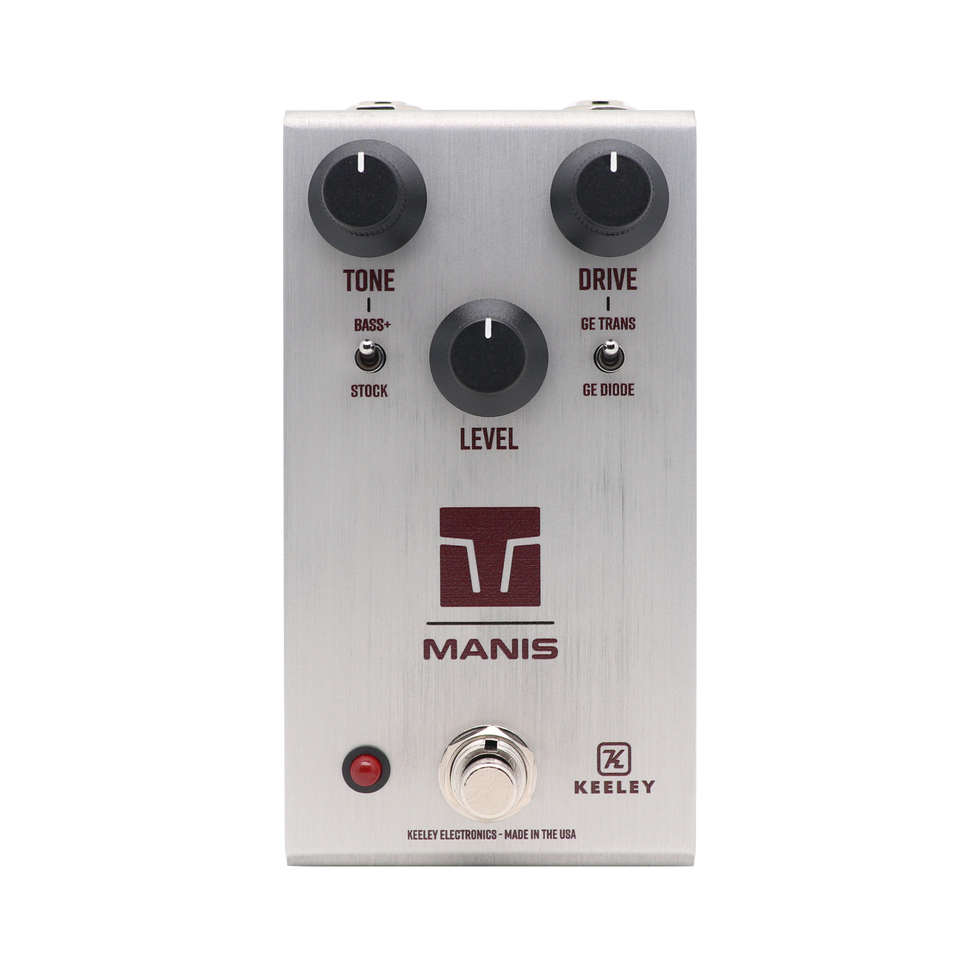
The Keeley Manis Overdrive uniquely combines both germanium NOS transistors and diodes for more compression and saturation plus a 3db bass-boost makes it unlike any other mythical Klone!
Keeley pens the next chapter in the legend of the mythical Klone with several storied upgrades and features. First up is the germanium diode switch. The “essential” germanium diodes are at the heart of the myth. By substituting essential germanium diodes with germanium transistors (circa Cold War era) we increase the compression and saturation of the tone. The Manis can give you a softer attack that sounds more like a tube amp. Less ice-pick, more tube amp. This feels incredible under your fingertips too. Wouldn’t you like to hear a little more of the natural low end from your guitar? The bass boost switch lowers the cutoff by exactly one octave and increases the output by +3dB. It’s the perfect low end recovery and push for single coil guitars. True Bypass or Buffered Silent Switching on the fly. The Manis is built like a tank and is the first klone you can power with 18 volts. The Manis is a Hard Clipping ‘clean boost’ that has been updated and modernized with our power supply improvements as well as other mind bending fixes to the inherent tonal problems of the original circuit.
- The Manis is Hard Clipping “clean boost” using Russian transistors as germanium diodes
- Ge-Trans Switch – Diodes or Transistors – Huge difference in feel with increased saturation and tube like compression
- The Bass+ Switch – Lowers the frequency response by one octave and then pushes 3dB harder
- True-Bypass or Buffered Bypass/silent Switching – Whichever works and sounds best in your rig.
A Soulful Sound for More Players: Taylor’s Gold Label Collection Grows
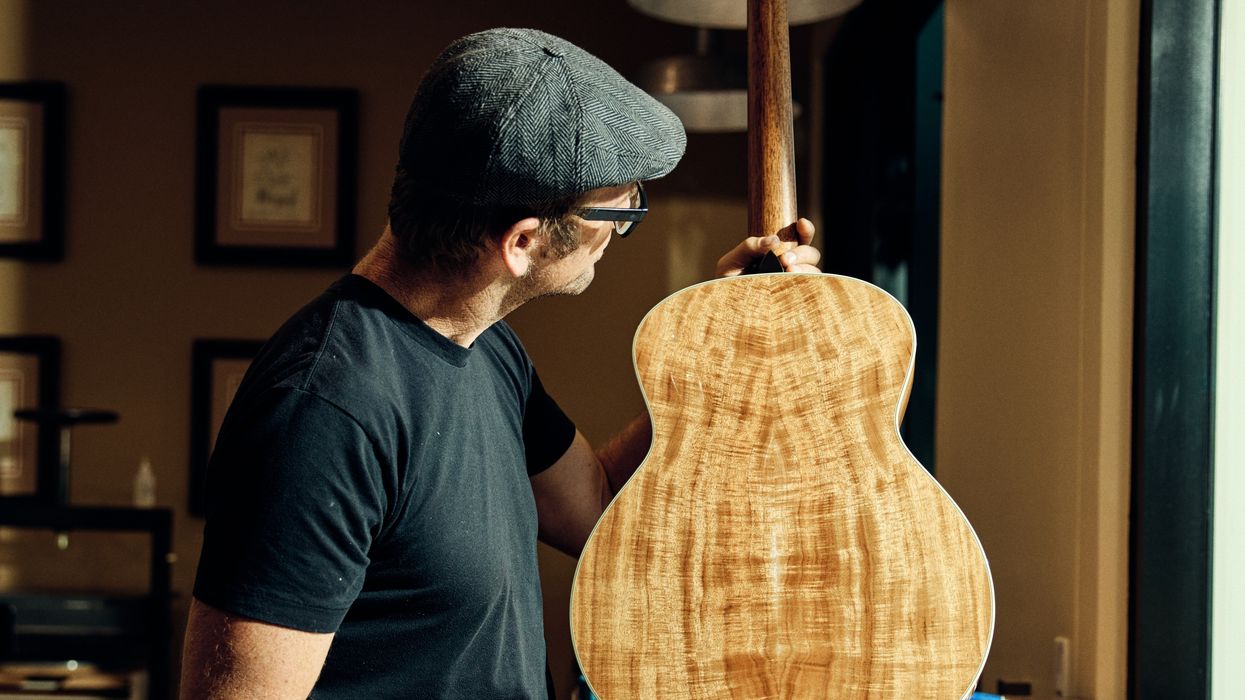
For years, Taylor Guitars design guru Andy Powers was ruminating on a sound. It was something deep and warm, with the soul of a bygone era—but unrealized in Taylor’s lineup.
Like any relentless innovator and natural luthier, Powers set out to develop an instrument that could channel this “new-old” sound while preserving the essential feel and musicality of a Taylor guitar. That effort came to life with the unveiling of the Gold Label Collection, launched at the 2025 NAMM Show. This new family of guitars introduced a warmer, fuller, more robust acoustic voice to the Taylor landscape—one that lives comfortably alongside the high-fidelity sound Taylor players have long embraced.
The new heritage-style sound has been made possible by a three-part sonic recipe, including one of two new non-cutaway body shapes (the Super Auditorium and deeper-bodied Grand Pacific, a round-shoulder dreadnought), a new internal bracing pattern and an innovative long-tenon neck joint design.
The Super Auditorium was designed with a slightly longer body and wider lower bout than Taylor’s flagship Grand Auditorium, serving up an open, muscular sound with warm, heavy-bodied trebles. “There’s a kind of honesty in this voice,” Powers says. “It’s not about hi-fi precision or isolated detail—it’s about a more natural kind of musicality. There’s warmth and fullness, but it still responds easily to your touch.” With its comfortable proportions and balanced tone from the lower to upper register, the Super Auditorium retains the versatility of Taylor’s original Grand Auditorium while delivering a fuller, more traditional tone.
But the Super Auditorium wasn’t the only body style envisioned for the collection. Equally central to the lineup is a reimagined version of Powers’ original slope-shoulder dreadnought Grand Pacific, an acoustic shape that doubles down on the sonic warmth and depth that inspired the entire project. For the Gold Label Collection, he’s added an extra 3/8-inch of depth at the soundhole. The extra lung capacity creates a deeper resonant frequency and contributes to a sound that has been compared to “sonic comfort food.” Compared to the Super Auditorium, the Grand Pacific’s broader curves and deeper body yield enhanced low-end power and projection, with a more seasoned, blended sonic character that invites players to really dig in.
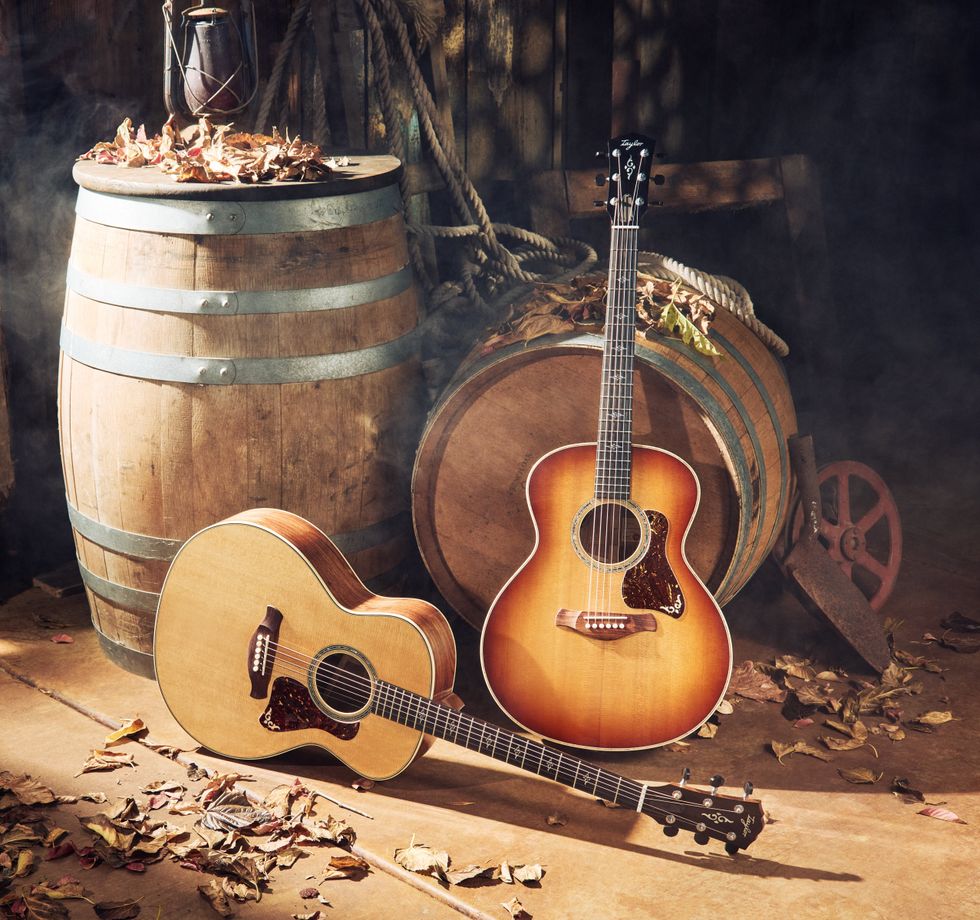
The aforementioned long-tenon neck joint is just one design element of Powers’ patented Action Control Neck™—currently featured exclusively on Gold Label models. The glueless, long-tenon design enhances the wood coupling between neck and body, further boosting low-end resonance. Perhaps the most ingenious part of the Action Control Neck’s design is its namesake string height adjustability. Players and technicians can adjust the action in seconds by using a quarter-inch nut driver (or standard truss rod wrench) on a bolt in the neck block, accessible through the soundhole. For guitarists jumping between different climate conditions, playing styles and musical applications, or just looking to dial in their ultimate playing setup, the Action Control Neck is a game changer. And the neck’s slim profile ensures players have the familiar hand-friendly playing experience expected from a Taylor guitar.
The first guitars to showcase the old-school sonic personality of the Gold Label Collection were a group of Super Auditorium models introduced at Taylor’s traditional 800 Series level, including the torrefied spruce/Honduran rosewood Gold Label 814e. After playing a Gold Label Super Auditorium for the first time, singer, songwriter and Asking Alexandria frontman Danny Worsnop says he was “blown away” by the warmth and fullness of the sound, and that he loved the easy neck adjustability. “It is a massive deal,” he says. “When it comes to traveling musicians, it’s absolutely game changing.”
Since the collection’s initial launch, Taylor has introduced a family of powerhouse Gold Label Grand Pacific models—three at Taylor’s 500 Series level, built with solid mahogany and torrefied spruce, and three at the 700 Series level, with Indian rosewood and torrefied spruce. Each model comes with one of three top finish options. The Gold Label 517e and 717e feature a natural top for a classic acoustic look. A black top finish and cream colored pickguard give the Gold Label 517e Blacktop and 717e Blacktop a bold, stage-ready visual presence. Players can choose either a cream or firestripe pickguard for the sunburst-top Gold Label 517e SB and 717e SB. The mahogany models offer a woody, dry attack and seasoned warmth, while the rosewood versions add extra depth and harmonic complexity.
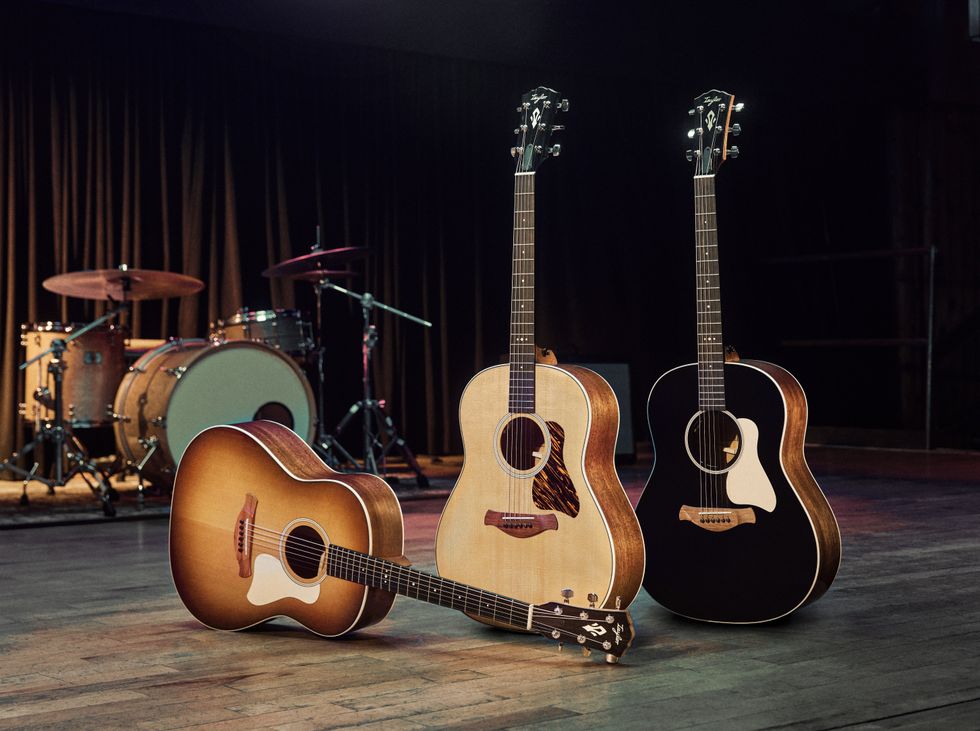
Artists across genres have rallied around the Gold Label Grand Pacific models, praising their warmth, resonance and stage-ready presence. “There’s not a more popular instrument to play in Nashville than an acoustic guitar,” says solo artist Gina Venier, “and I feel like I’ve got the top dog in the game right now.” Others echo that sense of discovery and connection. Chris Conley of Saves the Day calls the Gold Label 717e “the world’s most perfect acoustic guitar,” citing its “neck so buttery and beautiful” and “resonance so rich and warm.” Tiger’s Jaw’s Ben Walsh describes his Gold Label 717e as “the acoustic guitar I will grow old with,” while Jon Simmons of Balance and Composure praises his Gold Label 517e for feeling “so natural to play” and sounding “perfect” both unplugged and onstage. Longtime producer and engineer Ben Moore (Blink 182, Switchfoot) put it succinctly: “At this point, I thought I knew what a Taylor guitar sounds like. I couldn't have been more wrong.”
Each guitar in the Gold Label lineup sports Andy Powers’ modified headstock shape, with an angled back cut and a script-style Taylor logo inlay. His newly stylized pickguard shape is another visual hallmark of the collection and gets a dual-layer treatment with an engraved “Continental” design on 800 Series models.
The Gold Label Collection introduces a new sonic dimension to what’s thought of as the “traditional Taylor sound”—one rooted in tradition and elevated by innovation. Whether you’re drawn to the versatility of the Super Auditorium or the power of the Grand Pacific, these guitars invite players into this new breed of Taylor tone, where old-heritage inspiration meets modern musical expression. Gold Label guitars are available at authorized Taylor dealers.
Fender Introduces The New ‘American Ultra Luxe Vintage’ Guitar Range
Latest models combine modern playability with authentic vintage vibes, thanks to elements like Pure Vintage pickups, aged Heirloom™ lacquer finishes, and stainless-steel frets.
Fender Musical Instruments Corporation (FMIC) today announces the launch ofAmerican Ultra Luxe Vintage. Built upon the original American Ultra II models, this new collection represents the pinnacle of Fender innovation and craftsmanship, setting the benchmark for premium electric instruments whilst showcasing the finest of the brand's heritage – where timeless classics meet uncompromisingly modern technological refinement.
At the heart of this collection are the '50s and '60s custom editions of the legendary Stratocaster® and Telecaster® models. Paying homage to the golden era of Fender's innovation, these instruments all feature Pure Vintage Pickups with advanced electronics and S-1 Switching, to capture the distinctive sound and feel that has propelled the brand to pioneer status in its field. Every curve, contour, and detail has been carefully reproduced and finished in Meticulously Aged Heirloom™ Nitrocellulose Lacquer, with each guitar model boasting a quartersawn maple neck with upgraded stainless steel frets.
Complementing these classics is the HSS '60s Stratocaster® model, an instrument designed to offer expanded tonal versatility without sacrificing its vintage soul. With its powerful Pure Vintage ‘61 Single-Coil Strat® pickups at the neck and a Haymaker™ Humbucker sitting by the bridge, this model provides an extensive sonic palette; from warm, nuanced cleans to searing, high-gain leads, all while maintaining the iconic Stratocaster® voice, also finished in Fender’s trademark Meticulously Aged Heirloom™ Nitrocellulose Lacquer.
Key Features Include:
- Heirloom™ lacquer finish: A meticulously aged Heirloom lacquer finish lets the tone wood breathe as it wears naturally and uniquely.
- Iconic pickups: Get genuine classic Fender tone from the Pure Vintage pickups and powerful,
articulate crunch from the Haymaker™ Humbucker.
- Stainless steel frets: Fast playing and nearly indestructible, stainless steel frets are preferred for their consistency and durability
“With the American Ultra Luxe Vintage series, we’ve redefined the balance between heritage and innovation,” said Max Gutnik, Chief Product Officer, FMIC. “This collection honors our iconic legacy while pushing the boundaries of modern craftsmanship. Every detail is built for exceptional tone, feel, and timeless style. We’re proud to offer players an elevated experience that respects tradition and sets a new standard for performance.”
The American Ultra Luxe Vintage series offers musicians the best of both worlds: classic Fender design, timeless elegance, and historical significance, combined with modern sonic engineering's unparalleled performance and versatility. These instruments are an evolution that honours the legacy that continues to define the Fender brand while being cherished by a new generation of players.
American Ultra Luxe ‘50s Stratocaster®
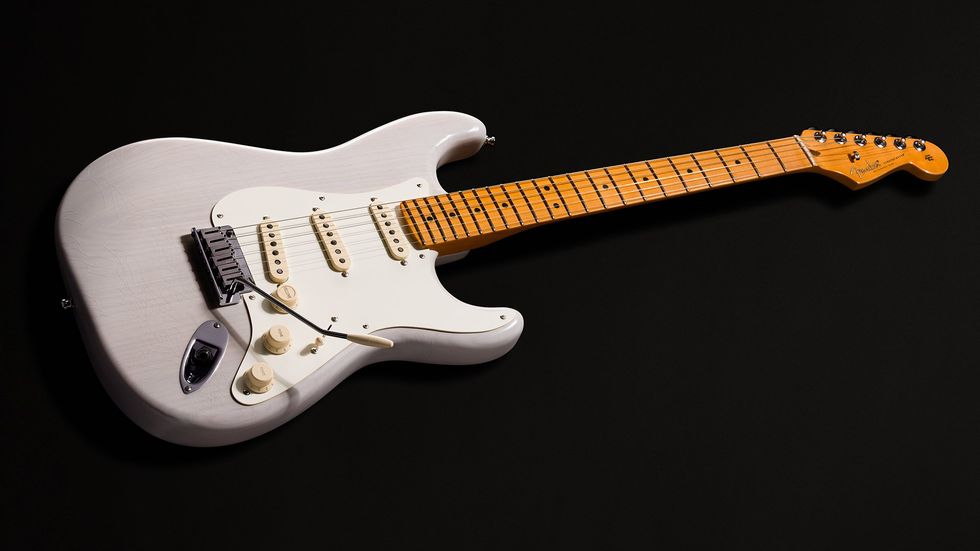
($2,849.99-$2,999.99 USD, £2,899.00-£2,949.00 GBP, €3,449.00-€3,499.00 EUR, $5,199-$5,399 AUD, ¥489,500 JPY) Representing the pinnacle of innovation and craftsmanship, Fender American Ultra Luxe sets the benchmark for premium electric instruments. The new American Ultra Luxe Vintage series takes it a step further, showcasing the finest of Fender heritage – where timeless classics meet uncompromising modern refinement. The American Ultra Luxe Vintage 50s Stratocaster® features premium ash or alder with carved contours that complement the aged Heirloom™ lacquer finish. Built for precision performance, the quartersawn maple neck with a Modern ‘D’ shape and Ultra rolled edges features medium jumbo stainless-steel frets, Luminlay® side dots and a Graph Tech TUSQ® nut. Each instrument features a tapered neck heel to ensure unparalleled access to the higher register. Under the hood, Pure Vintage ’57 Strat® pickups deliver classic Fender tones, from sparkling cleans to rich, expressive leads. Performance hardware includes a precision-engineered 2-Point American Ultra synchronized tremolo with polished stainless steel block saddles, cold rolled steel block, and deluxe locking tuners for quick string changes and superior tuning stability. The American Ultra Lux Vintage 50s Stratocaster® delivers flawless modern performance with distinctive classic design. Available in3-Color Sunburst and White Blonde.
Fender American Ultra Luxe Vintage '50s Stratocaster Maple Fingerboard Electric Guitar
American Ultra Luxe ‘60s Stratocaster®
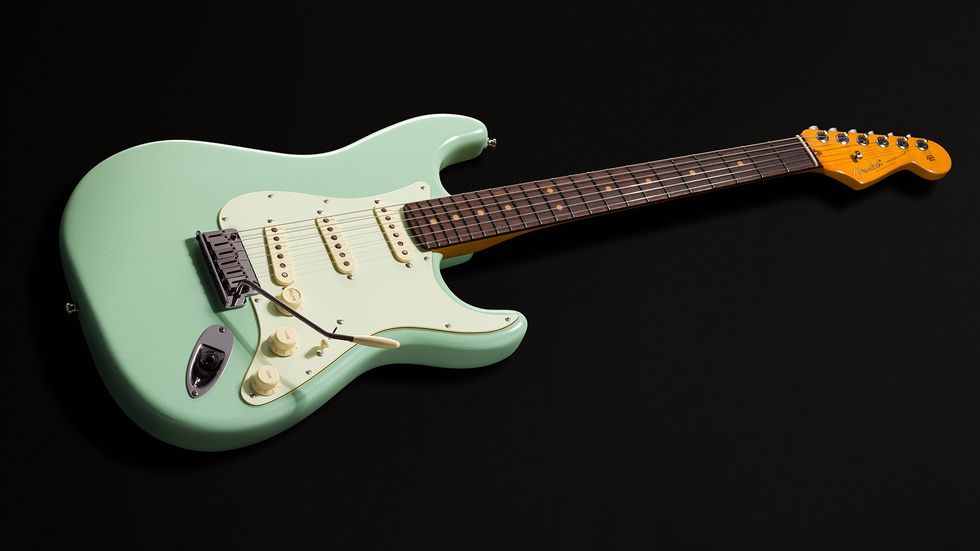
($2,849.99 USD, £2,899 GBP, €3,449, $5,199 AUD, ¥489,500 JPY) Representing the pinnacle of innovation and craftsmanship, Fender American Ultra Luxe sets the benchmark for premium electric instruments. The new American Ultra Luxe Vintage series takes it a step further, showcasing the finest of Fender heritage – where timeless classics meet uncompromising modern refinement. The American Ultra Luxe Vintage 60s Stratocaster features premium alder with carved contours that complement the aged Heirloom™ lacquer finish. Built for precision performance, the quartersawn maple neck with a Modern ‘D’ shape and Ultra rolled edges features medium jumbo stainless- steel frets, Luminlay® side dots, and a Graph Tech TUSQ® nut. Each instrument features a tapered neck heel to ensure unparalleled access to the higher register. Under the hood, Pure Vintage ’61 Strat® delivers classic Fender tones, from sparkling cleans to rich, expressive leads. Performance hardware includes a precision-engineered 2-Point American Ultra synchronized tremolo with polished stainless steel block saddles, cold rolled steel block, and deluxe locking tuners for quick string changes and superior tuning stability. The American Ultra Lux Vintage 60s Stratocaster® delivers flawless modern performance with distinctive classic design. Available in Ice Blue Metallic and Surf Green
Fender American Ultra Luxe Vintage '60s Stratocaster Rosewood Fingerboard Electric Guitar
American Ultra Luxe ‘60s Stratocaster®
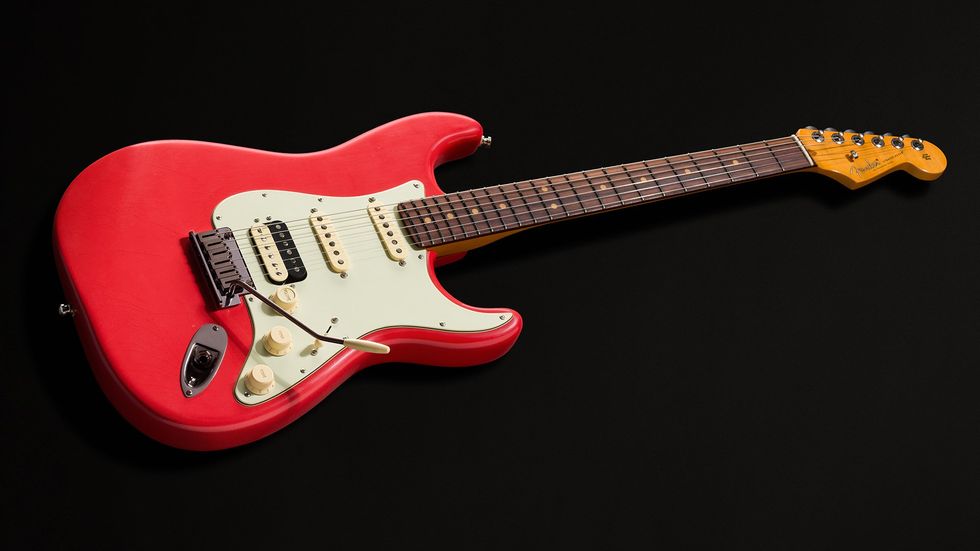
($2,899.99 USD, £2,749 GBP, €3,249 EUR, $5,299 AUD, ¥500,500 JPY) Representing the pinnacle of innovation and craftsmanship, Fender American Ultra Luxe sets the benchmark for premium electric instruments. The new American Ultra Luxe Vintage series takes it a step further, showcasing the finest of Fender heritage – where timeless classics meet uncompromising modern refinement.The American Ultra Luxe Vintage 60s Stratocaster® HSS features premium alder with carved contours that complement the aged Heirloom™ lacquer finish. Built for precision performance, the quartersawn maple neck with a Modern ‘D’ shape and Ultra rolled edges features medium jumbo stainless-steel frets, Luminlay® side dots, and a Graph Tech TUSQ® nut. Each instrument features a tapered neck heel to ensure unparalleled access to the higher register.Under the hood, Pure Vintage ’61 Strat® single-coils deliver classic Fender tones, from sparkling cleans to rich, expressive leads while the Haymaker™ humbucker brings powerful, articulate crunch. Performance hardware includes a precision-engineered 2-Point American Ultra synchronized tremolo with polished stainless steel block saddles, cold rolled steel block, and deluxe locking tuners for quick string changes and superior tuning stability.The American Ultra Luxe Vintage 60s Stratocaster® HSS delivers flawless modern performance with distinctive classic design. Available in Fiesta Red and Sea Foam Green.
Fender American Ultra Luxe Vintage '60s Stratocaster HSS Rosewood Fingerboard Electric Guitar
American Ultra Luxe ‘50s Telecaster®
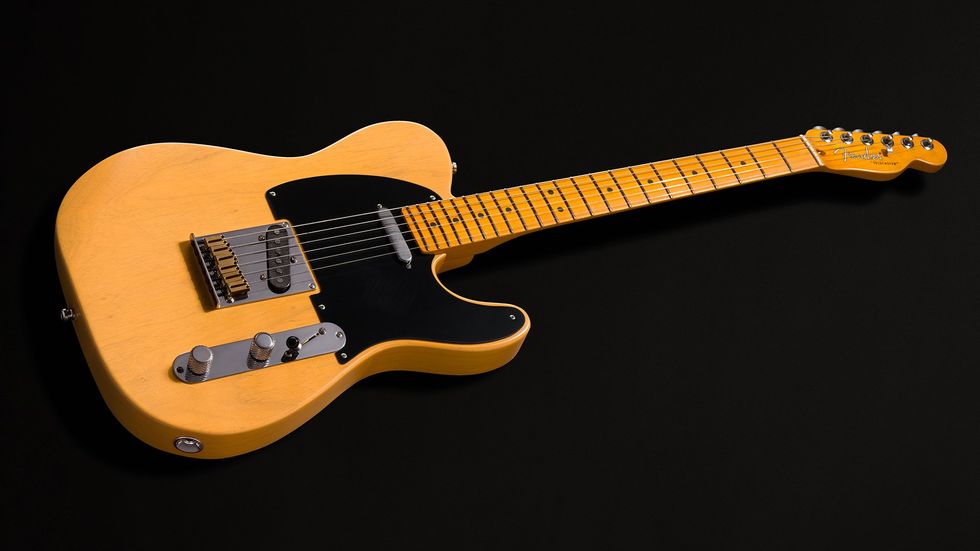
($2,999.99 USD, £2,949 GBP, €3,499 EUR, $5,399 AUD, ¥511,500 JPY) Representing the pinnacle of innovation and craftsmanship, Fender American Ultra Luxe sets the benchmark for premium electric instruments. The new American Ultra Luxe Vintage series takes it a step further, showcasing the finest of Fender heritage – where timeless classics meet uncompromising modern refinement. The American Ultra Luxe Vintage 50s Telecaster® features premium ash with carved contours that complement the aged Heirloom™ lacquer finish. Built for precision performance, the quartersawn maple neck with a Modern ‘D’ shape and Ultra rolled edges features medium jumbo stainless- steel frets, Luminlay® side dots, and a Graph Tech TUSQ® nut. Each instrument features a tapered neck heel to ensure unparalleled access to the higher register. Under the hood, Pure Vintage ’51 Tele® pickups deliver classic Fender tones, from sparkling cleans to rich, expressive leads. Performance hardware includes a precision-engineered 6-saddle string-though-body bridge with brass block saddles and deluxe locking short post tuners for quick string changes and superior tuning stability. The American Ultra Luxe Vintage 50s Telecaster® delivers flawless modern performance with distinctive classic design. Available in Butterscotch Blonde and White Blonde.
Fender American Ultra Luxe Vintage '50s Telecaster Maple Fingerboard Electric Guitar
American Ultra Luxe ‘60s Custom Telecaster®
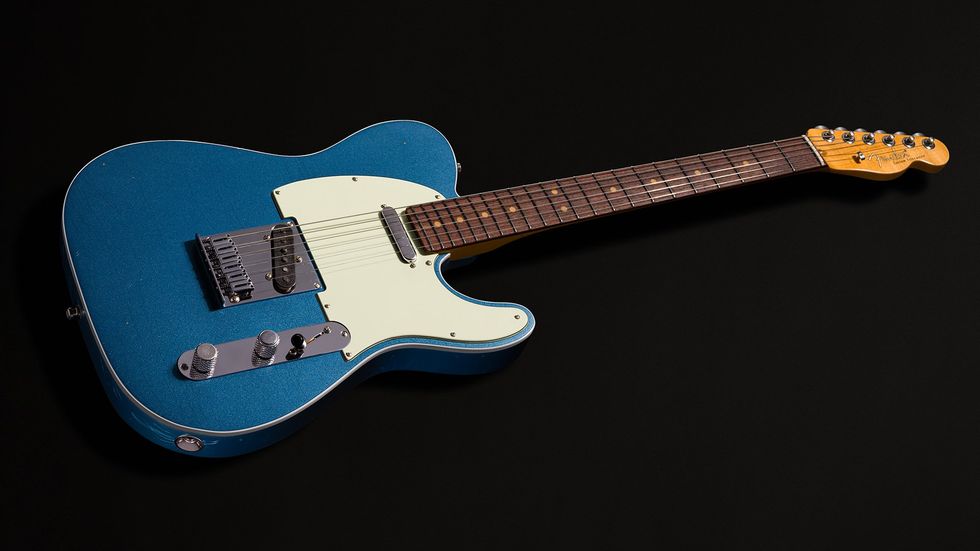
($2,999.99 USD, £2,949 GBP, €3,499 EUR, $5,399 AUD, ¥511,500 JPY) Representing the pinnacle of innovation and craftsmanship, Fender American Ultra Luxe sets the benchmark for premium electric instruments. The new American Ultra Luxe Vintage series takes it a step further, showcasing the finest of Fender heritage – where timeless classics meet uncompromising modern refinement. The American Ultra Luxe Vintage 60s Custom Telecaster® features premium alder with carved contours that complement the aged Heirloom™ lacquer finish. Built for precision performance, the quartersawn maple neck with a Modern ‘D’ shape and Ultra rolled edges features medium jumbo stainless-steel frets, Luminlay® side dots, and a Graph Tech TUSQ® nut. Each instrument features a tapered neck heel to ensure unparalleled access to the higher register. Under the hood, Pure Vintage ’63 Tele® pickups deliver classic Fender tones, from sparkling cleans to rich, expressive leads. Performance hardware includes a precision-engineered 6-saddle string-through-body bridge with chromed brass block saddles, and deluxe locking short post tuners for quick string changes and superior tuning stability. The American Ultra Luxe Vintage 60s Custom Telecaster® delivers flawless modern performance with distinctive classic design. Available in 3-Color Sunburst and Lake Placid Blue.
Fender American Ultra Luxe Vintage '60s Custom Telecaster Rosewood Fingerboard Electric Guitar
D’Addario Jack Plugs: Protect Your Gear
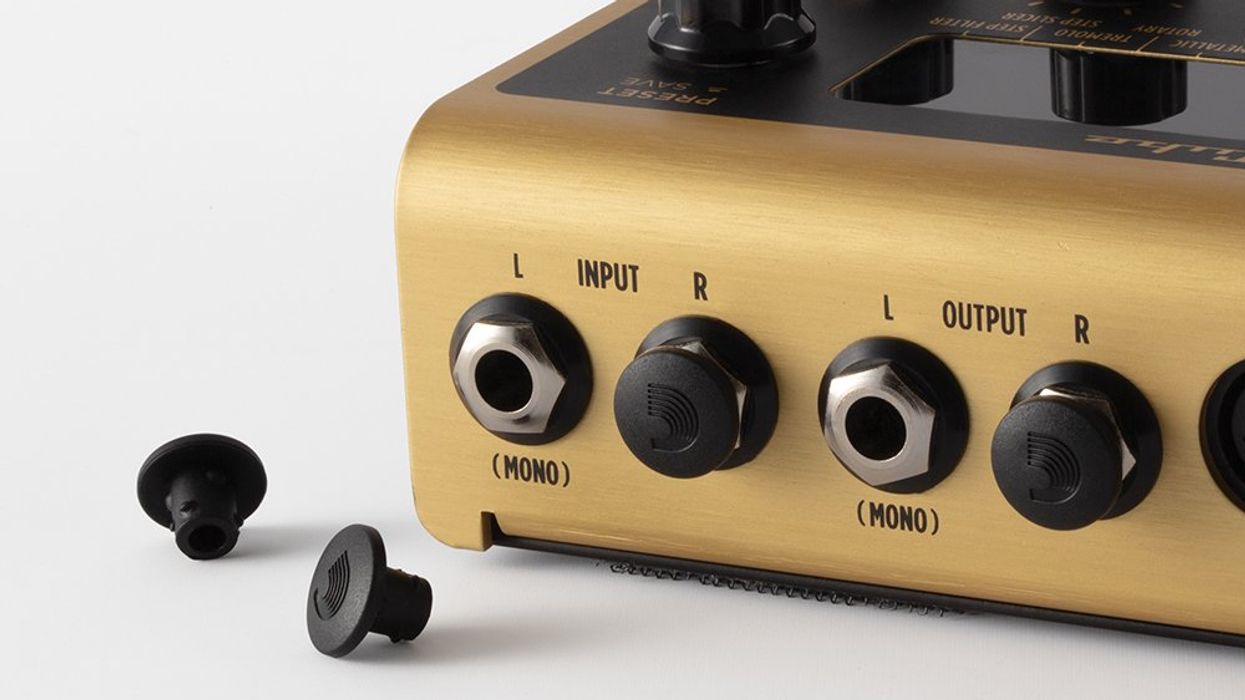
D’Addario is proud to introduce Jack Plugs: a fast, effective way to block unused ¼" jacks on pedals, amps, and audio gear. Touring guitarists, studio engineers, and live sound techs alike can prevent accidental connections, speed up the rig set up process, and protect their gear from dust, debris, and interference. Even better, installing these small, easy-to-use accessories is simple and requires no tools, minimum hassle, and no cleanup.
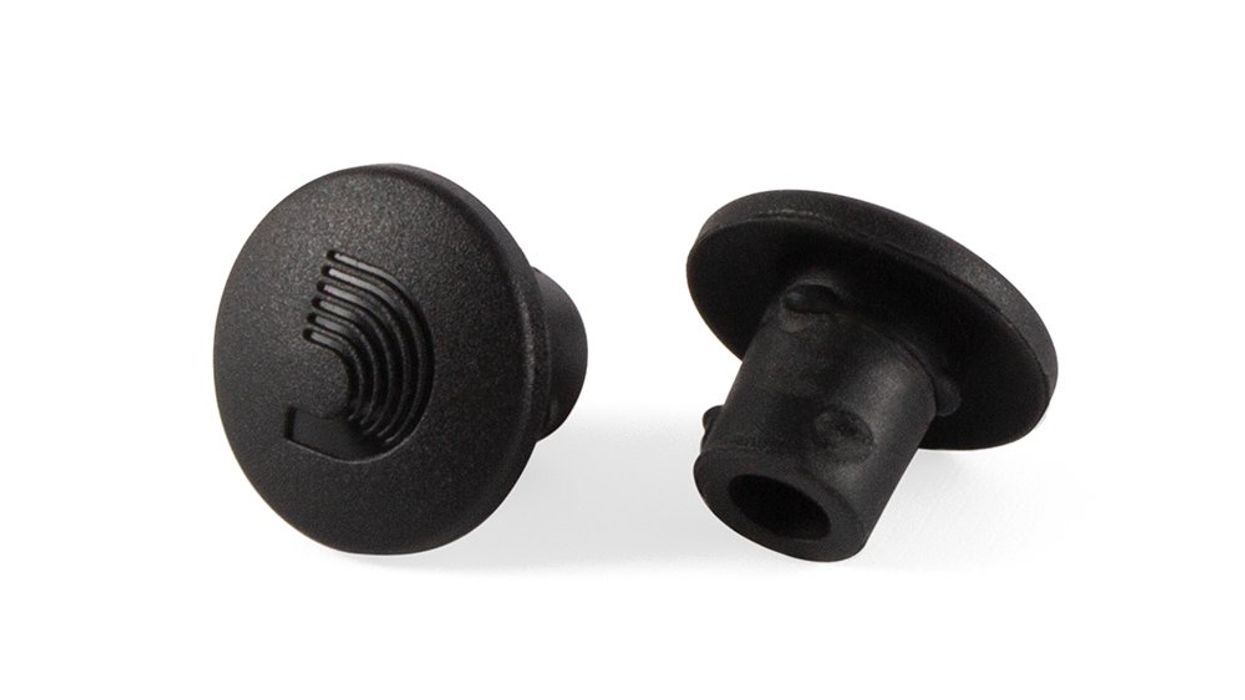
Small Solution, Big Impact
“We created the Jack Plugs to solve a problem we kept seeing on stage and experienced ourselves — accidental connections that kill your signal or worse, damage your gear.” As Product Development Manager Robert Cunningham put it, “these plugs are a simple fix that prevent mispatching, especially with speaker outputs where the wrong ohm load can be a real issue. They're small and inexpensive but they’ll save countless gigs.”
Features:
- Blocks unused jacks to avoid unwanted signal paths or disruptions
- Shields open ports from dust, debris, and potential damage.
- Simple plug-and-play design for fast setup and removal.
- Ideal for musicians, studio engineers, and live sound techs.
- Maintains a clean, organized rig for optimal audio performance.
Product Info:
- Street Price: $4.99
- Available now at daddario.com and through participating retailers and distributors
- More Info: https://ddar.io/jackplugs-pr
- Product Images: Available via Dropbox









